Ferdinand Porsche
(1875 – 1951)
Ferdinand Porsche was an Austrian-German automotive engineer and founder of the Porsche car company. He is best known for creating the first gasoline-electric hybrid vehicle, the Volkswagen Beetle, the Auto Union racing car, the Mercedes-Benz SS/SSK and several other important automobiles and technologies. Most importantly though, for fans of the best sports cars in the world, Ferdinand Porsche is the founder of Porsche automobiles and his ambition and engineering prowess are why we get to enjoy Porsches so much today.
The Basics
Design engineer Professor Dr. Ing. h.c. Ferdinand Porsche, the third of five children, was born in Maffersdorf (now: Vratislavice/Czech Republic) on 3rd September 1875. His father, Anton Porsche, was the owner of a plumbing workshop. Anton’s son, Ferdinand, was expected to take over the family business, but he had other interests: at the age of 14 he was already performing experiments with electricity. However, his father was not very impressed with this. On the contrary, for a long time he tried to forbid his son from busying himself with “such nonsense”. Therefore, Ferdinand set up his own secret workshop in his parent’s house so that he could experiment unhindered.
Ferdinand Porsche was fascinated by electricity. After completing both his plumber apprenticeship and the state trade school in Reichenberg, he began working at the electrical company Bela Egger & Co. in Vienna (later became Brown Boveri) in 1893. His wealth of talent and technical grasp meant he was promoted from a worker to the test centre manager within a few years. His career path was characterised by groundbreaking designs. In 1897, he built an electric wheel-hub motor. In the same year, Ferdinand Porsche commenced work at k. u. k. Hofwagenfabrik Jacob Lohner & Co., Vienna, in the newly established “Electric Car Department”. In 1900, the Lohner-Porsche – a non-transmission vehicle powered by the Porsche wheel-hub engine – was celebrated as an epoch-making innovation at the world trade fair in Paris. Ferdinand Porsche also victoriously tested his designs in races. For instance, he won on the Semmering circuit near Vienna in 1900. In 1902, as a k. u. k. reserve foot soldier, he was the driver for Archduke Franz Ferdinand. He drove one of his own designs.
Ferdinand Porsche married Aloisia Johanna Kaes in 1903. The marriage produced two children, Louise and Ferdinand Anton Ernst (“Ferry”). His daughter Louise later married the Viennese attorney-at-law Dr. Anton Piëch. After his death in 1952, she assumed management of Porsche Konstruktionen GmbH, the predecessor of the contemporary Porsche Holding in Austria. After the war, his son Ferry assumed management; his flair for business turned the design and engineering company into a world-famous sports car producer.
In 1906, after eight years at Lohner, Ferdinand Porsche took up the position of Technical Manager at Austro-Daimler in Wiener Neustadt. He became General Manager in 1917. In 1910, at the wheel of an Austro-Daimler car that he designed himself, Ferdinand won the “Prinz-Heinrich Race”, which was popular at that time. It was a long-distance test for touring cars with annual varying routes. On that particular year, it was 1,495 kilometres long, and extended from Berlin through Magdeburg, Braunschweig, Kassel, Würzburg, Nuremberg, Stuttgart, Strasbourg and Trier to the finishing point at Bad Homburg. Ferdinand Porsche reached top speeds of up to 140 kilometres per hour on the track with his novel, aerodynamic, “tulip-shaped” car.
In 1922, Ferdinand Porsche presented the “Sascha”, a small 4-cylinder racing car with a displacement of 1.1 litres. At first go in the same year, the “Sascha” snapped up first and second places in its particular category in the Targa Florio race in Sicily. Gazetta dello Sport commented on its success as follows: “Up until very recently no one would have dreamed it possible to achieve such top speeds and durability with a 4-cylinder engine belonging to the category of smallest cars ever.” During the course of his employment as Technical Manager, Ferdinand Porsche created numerous designs, including high-performance aircraft engines and large tractive machines, as well as fire engines, trolley buses and transport systems with hybrid petrol-electric drive.
Ferdinand Porsche joined Daimler-Motoren-Gesellschaft in Stuttgart as a Technical Manager and an Executive Board member in 1923. He oversaw enhancement of the Mercedes compressor car. In 1924, he became the overall winner of the Targa Florio race in this car. The Institute of Technology (Technische Hochschule) in Stuttgart conferred the honorary title of Dr. Ing. on Ferdinand Porsche following this great achievement. His compressor designs Mercedes-Benz S, SS and SSK became synonymous for sportiness and racing success. Dr. Porsche left the company in 1929 and took up the position of Technical Manager at Steyr-Werke AG in Austria.
One and a half years later, Ferdinand Porsche set up his own independent design office, which was recorded in the Commercial Register on 25th April 1931 as “Dr. Ing. h. c. F. Porsche GmbH, Konstruktionen und Beratung für Motoren und Fahrzeuge” (design engineering and consultation for engines and vehicles). Already on 10th August 1931, the torsion bar suspension was registered as a patent, which a well-known specialist journalist later commented would have sufficed to commemorate the Porsche name in the automobile world. In 1932, Porsche was contracted by Auto Union to design a 16-cylinder compressor Grand Prix racing car for the new 750-kg formula. The Auto Union P-car (P for Porsche) won 32 races out of 64, and drivers such as Hans Stuck and Bernd Rosemeyer set many world records in it.
Ferdinand Porsche was already mulling over the idea of building a small car when he was at Austro-Daimler and Daimler-Benz. He wanted to create a high quality car suitable for everyday use, which was not just a smaller version of the known saloons.
On 22nd June 1934, a contract was concluded between the Porsche design office and the Reichsverband der Automobilindustrie (the umbrella organisation of the German automotive industry, which later became the Verband der Automobilindustrie (VDA)). It was the hour that Volkswagen was born. The founding stone was laid for the Volkswagen plant in 1938. In the following period, Ferdinand Porsche was one of the general managers of Volkswagen GmbH. Shortly before production started, the Second World War broke out. The Volkswagen initially served as a basis for developing the all-terrain or amphibian car.
In 1940, Ferdinand Porsche was conferred the honorary title of professor. During the war, the construction office developed the “Mouse” heavy tank and the “Ostrad” tractor, for example, and also worked on constructions such as wind generators or the people’s tractor (Volkstraktor). In autumn 1944, the Porsche design office was relocated from Stuttgart to Gmünd/Carinthia. Ferdinand Porsche lived in Gmünd/Carinthia and Zell am See towards the end of the war.
Ferdinand Porsche was arrested by the French at the end of 1945, and was subsequently held for 22 months in various prisons. Upon his return, he examined the design of the racing car Cisitalia, which was constructed under the management of his son Ferry. After close observation, he came to the conclusion: “I would have built it exactly the same, right down to the last screw.”
At the age of 75 Professor Dr. Ing. h.c. Ferdinand Porsche died 1951 in Stuttgart.
The Full Timeline & Visual History
1875
On September 3, 1875, Ferdinand Porsche, third of five children of Anton Porsche, was born in Maffersdorf, Reichenberg, Austro-Hungarian Empire (now Vratislavice nad Nisou, Liberec, Czech Republic).
1889-1890
At the age of 14, Ferdinand was already performing experiments with electricity. For example, he fitted ice skates with battery-powered lights. However, his father tried to forbid his son from busying himself with “such nonsense”. Anton Porsche was the owner of a plumbing workshop and expected Ferdinand to take over the family business after Ferdinand’s older brother Anton got killed in the workshop accident. But Ferdinand had other interests. Despite being fascinated by electricity, he completed both his plumber apprenticeship and the state trade school in Reichenberg.
Ferdinand’s acumen in electricity increased to such a degree that by 1893 his family home became the first in Maffersdorf to have electric light.


1893
Ferdinand began working at the electricity company Bela Egger & Co. (now Brown Boveri) in Vienna.
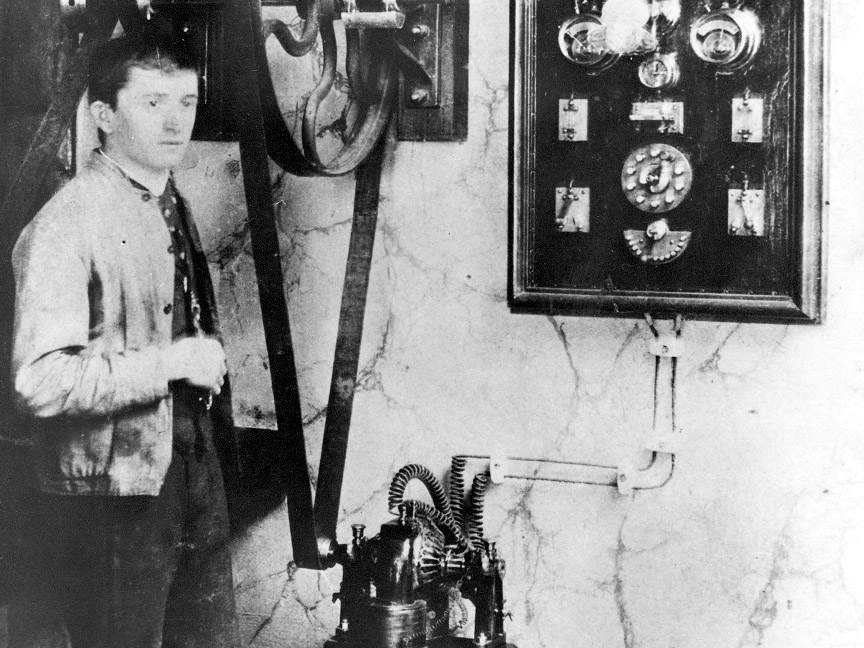
With his bright talent, Ferdinand Porsche was promoted from a worker to the test centre manager within a few years.
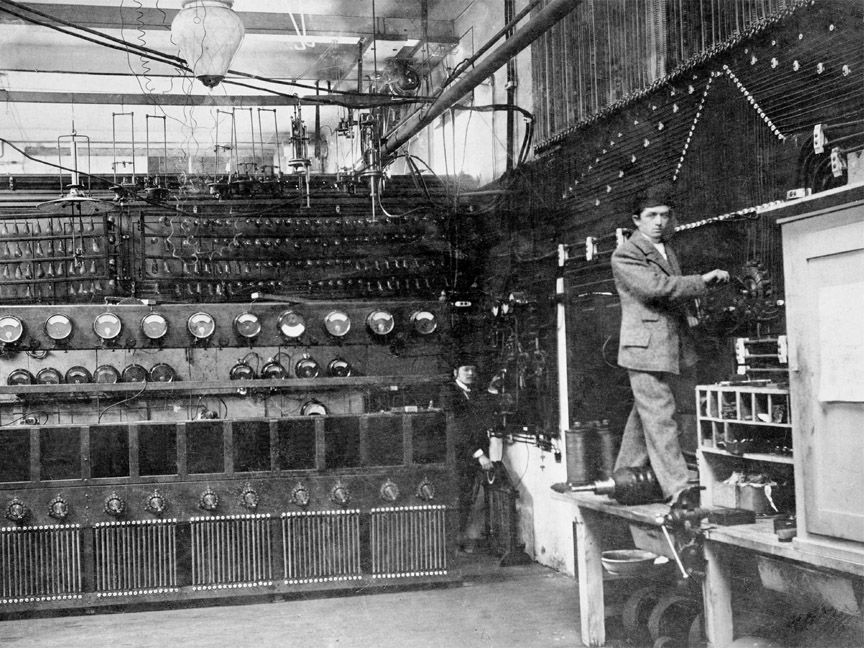
1897
F. Porsche built an electric wheel-hub motor. In the same year he started working at Hofwagenfabrik Jacob Lohner & Co., Vienna, in the freshly established car department.
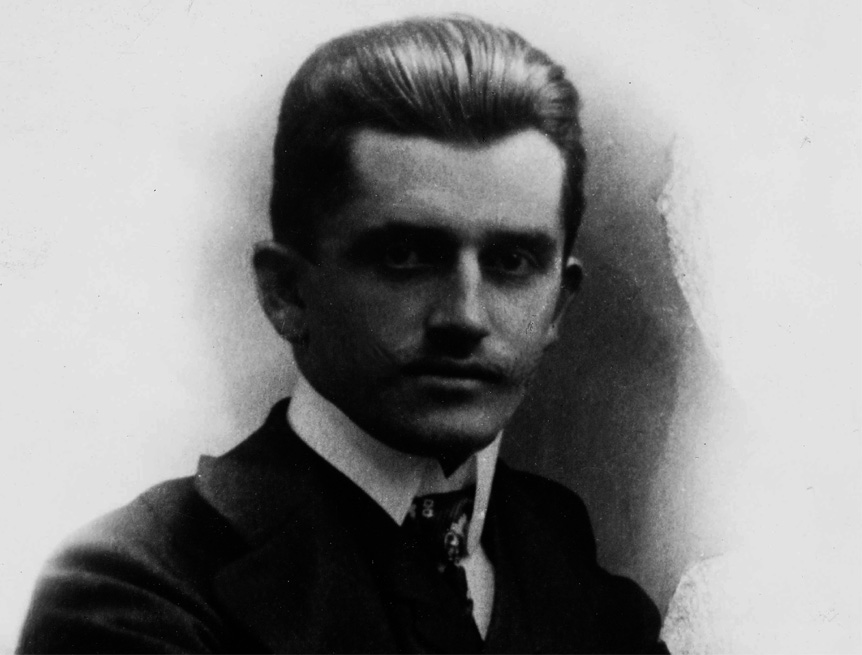
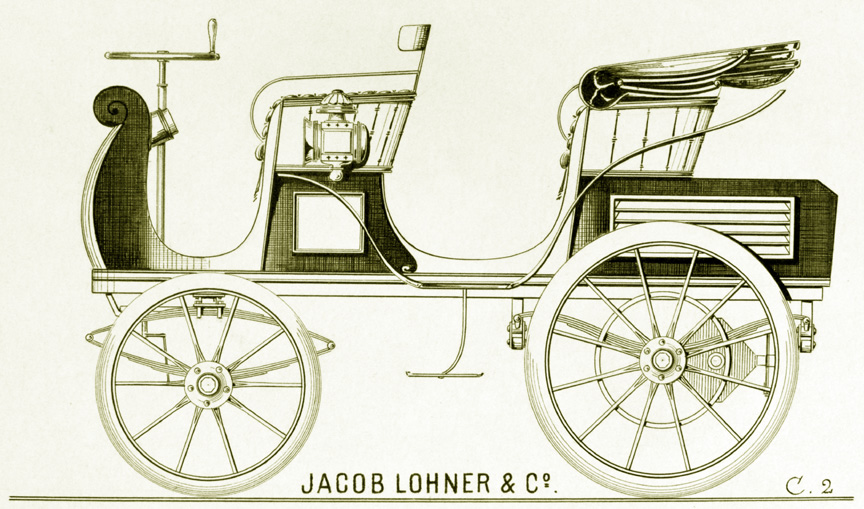
1898
The “P1” – designed and built by Ferdinand Porsche – was one of the first vehicles registered in Austria. It was taken to the streets of Vienna on June 26, 1898. The highly compact electric drive, weighing just 130 kg/290 lb, offered an output of 3 hp. For short periods, up to 5 hp could be achieved in overloading mode, allowing the P1 to reach up to 22 mph/35 km/h. The speed was regulated via a 12-speed controller. The first practical test awaited the P1 on September 28, 1899, at the international motor vehicle exhibition in Berlin – a race for electric vehicles over a distance of 40 km was announced! With three passengers on board, Ferdinand Porsche steered his P1 across the finish line as the winner.
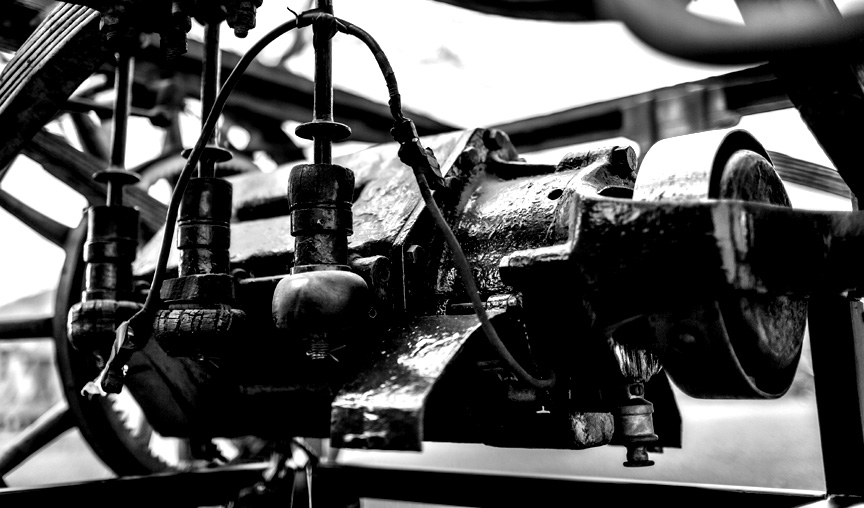
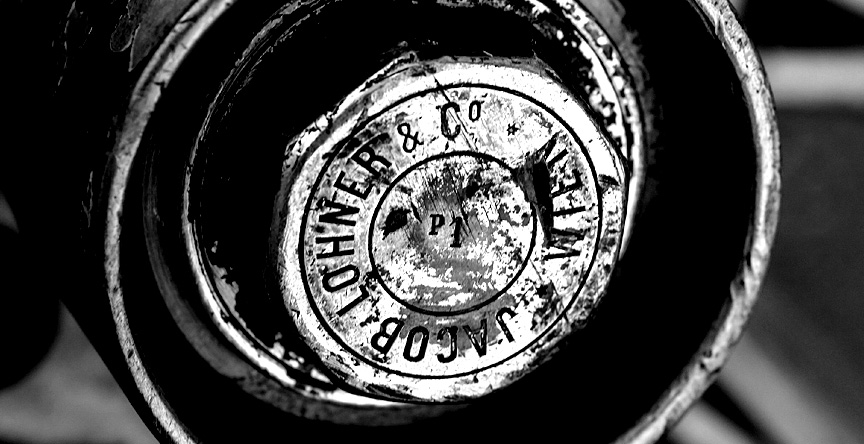
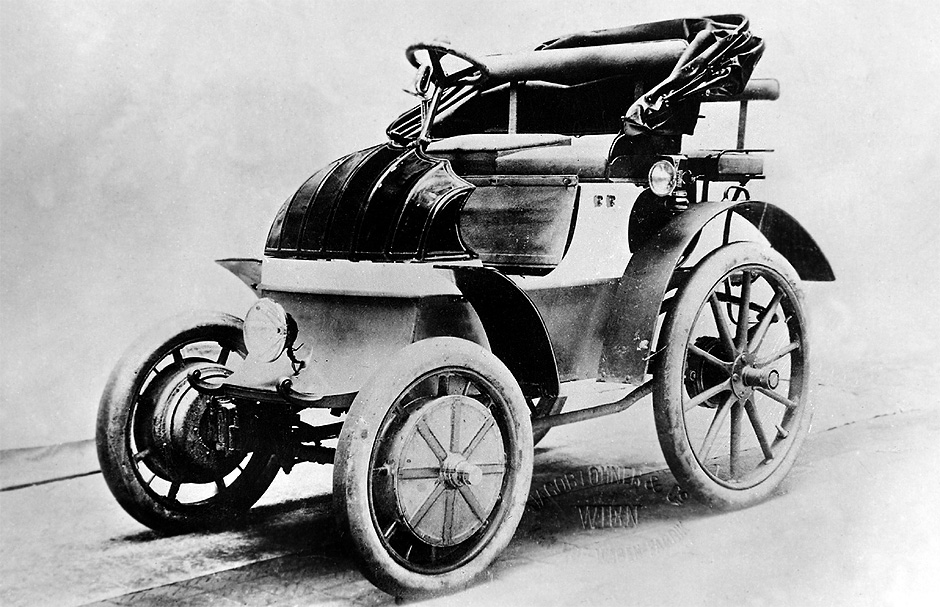
1900
The Lohner-Porsche – a vehicle powered by the Porsche electric wheel-hub motors – was celebrated as an epoch-making innovation at the world trade fair in Paris.
The Lohner-Porsche electric car, a “Chaise” (“Chair”) with the internal vehicle number 24000, was exhibited as the only Austrian car at the 1900 Paris World Fair. A news report at the time described the development of the first-ever transmissionless vehicle as a revolutionary innovation. The electric motors in the hubs of the front wheels had an output of 1.8 kW at 120 rpm. The 44-cell, 80-volt rechargeable battery with a capacity of 300 Ah gave the car a range of 30 miles/50 km between recharges. The maximum speed was 30 mph/50 km/h. The slow speed of the electric motor permitted direct drive and installation in the wheel. The motor operated without chains and thus without mechanical power loss. Consequently, the electric motor was extremely efficient and was almost silent during operation. The total weight of the vehicle was 1205 kg/2657 lbs. The car could be braked at all four wheels – by the motors at the front axle and with the aid of a mechanical strap brake at the rear axle. Ferdinand victoriously tested his designs in races – he won on the Semmering circuit near Vienna in 1900.
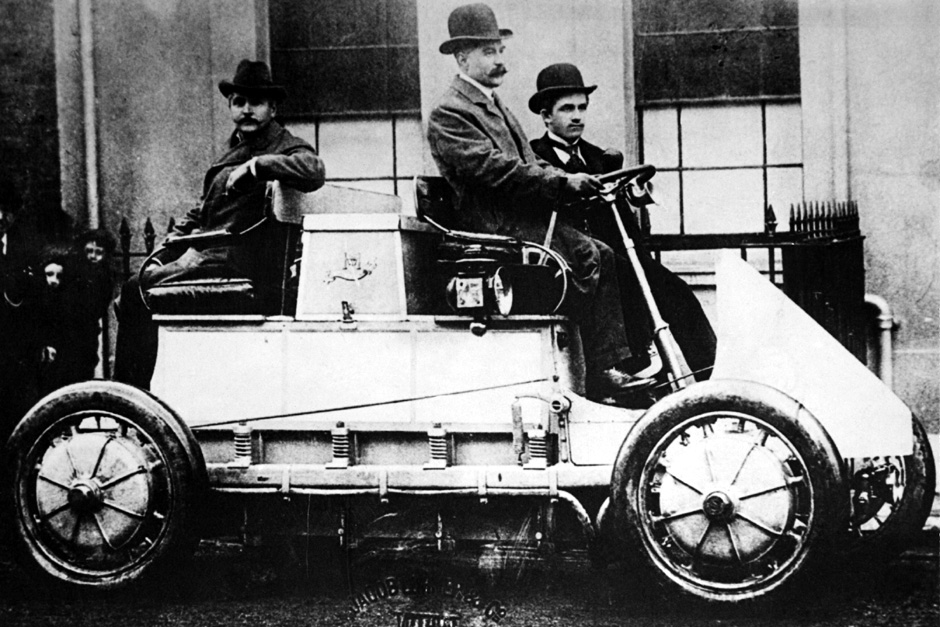
1902
In 1902 as a reserve soldier, Ferdinand Porsche was the driver for Archduke Franz Ferdinand (whose later assassination sparked World War I). Ferdinand drove one of his own designs.
1903
In 1903, Ferdinand Porsche married Aloisia Johanna Kaes.
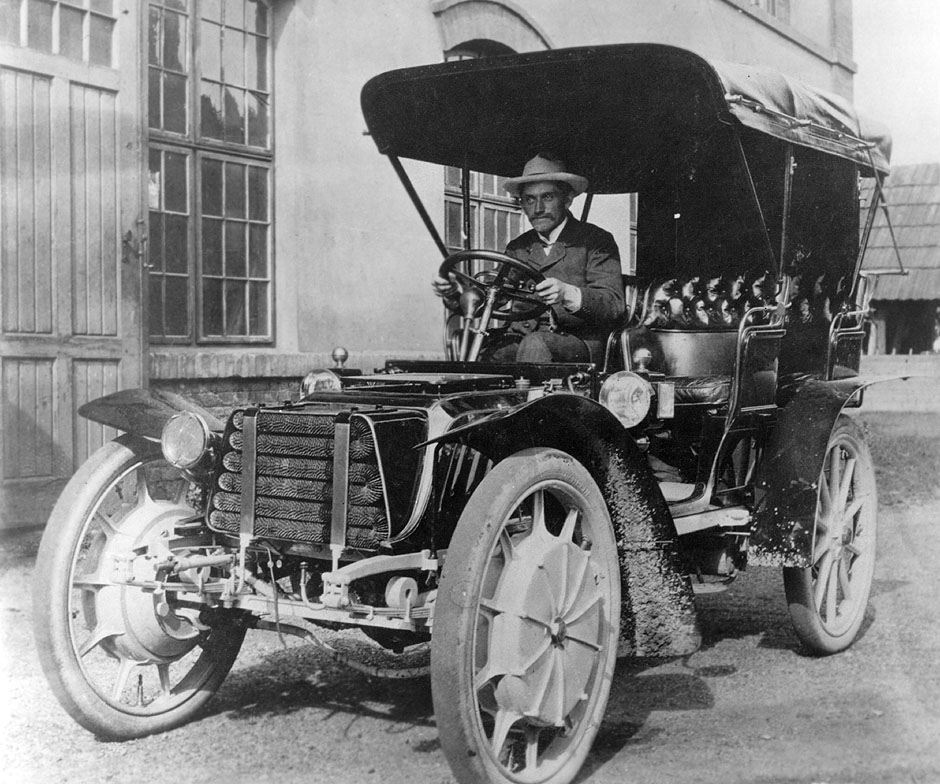
1904
In 1904, Daughter Louise Hedwig Anna Wilhelmine Maria Porsche (later Piëch) was born.
1906
In July 1906, after 8 years at Lohner, F. Porsche took up the position of Technical Director at Austro-Daimler in Wiener Neustadt. At the age of only 31, he was responsible for the model range of one of Europe’s largest automotive companies.
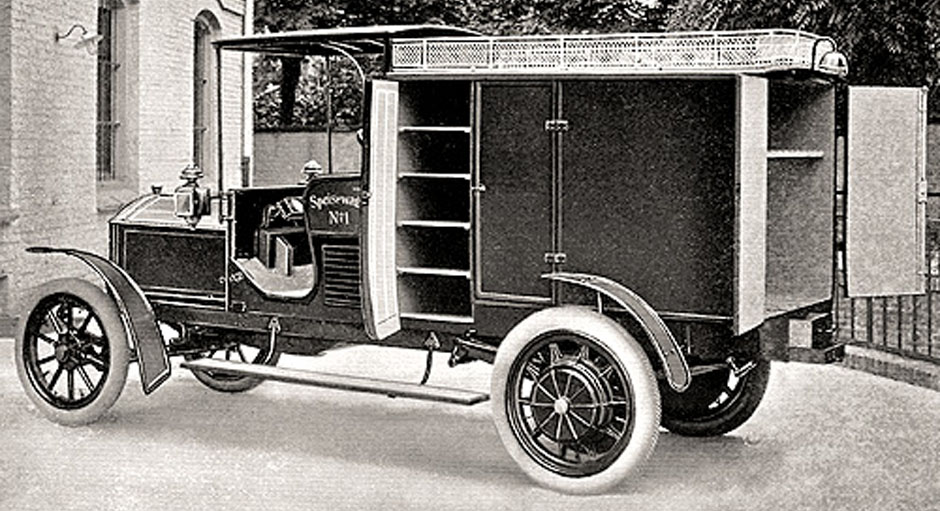
1908
The petrol/electric vehicles with electric wheel hub drive sold from 1908 were especially popular with city dwellers. Daimler’s Marienfelde plant produced trucks, beer transporters, waste collection and other municipal vehicles, buses for city tours and, above all, fire engines. The battery-powered and later petrol/electric drive systems were developed by Ferdinand Porsche for the Lohner company who had sold the patent to Daimler.
1909
On September 19, 1909, son Ferdinand Anton Ernst (“Ferry”) was born. On the same day Ferdinand was busy racing at Semmering, 40 km from home, in an Austro-Daimler Maja engineered by himself. He got the news about the birth of his son by telegram.

1910
In 1910, from June 2 to 8, at the wheel of an Austro-Daimler car that he designed himself, F. Porsche won the “Prinz-Heinrich-Fahrt”, which was popular at that time. It was a long-distance test for touring cars with annually varying routes. In 1910 the race was on the following course: Berlin-Magdeburg-Braunschweig-Kassel-Würzburg-Nürnberg-Stuttgart-Strasbourg-Metz-Bad Homburg. The race distance was 1945 km (1208 miles).
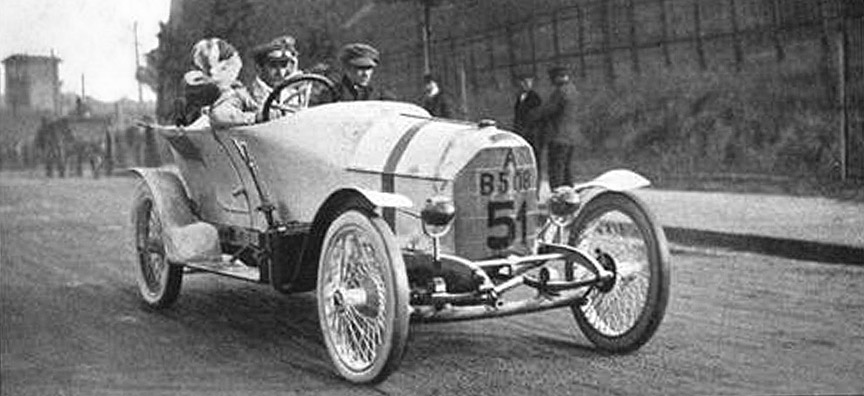
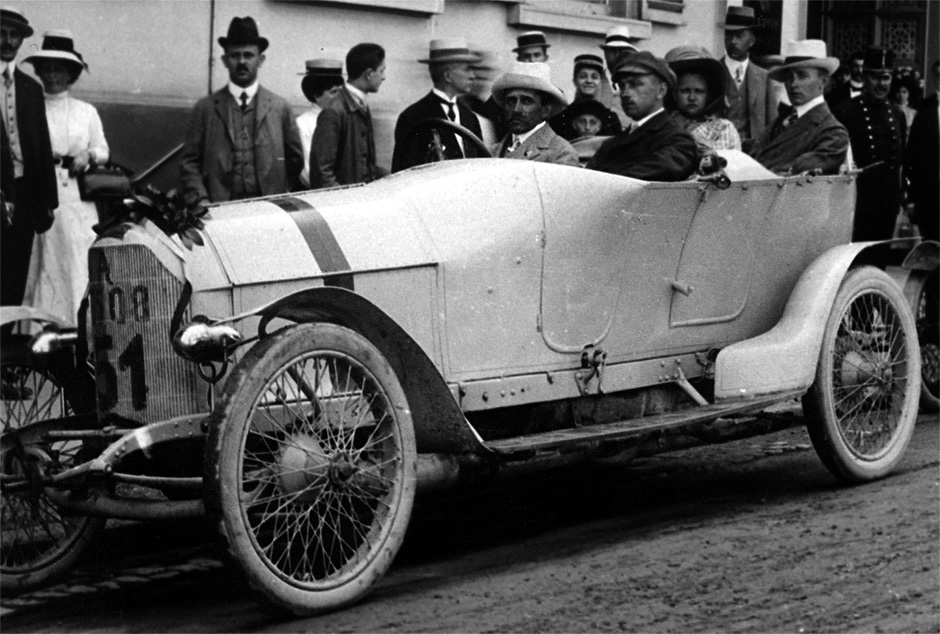
1912
Between 1912 and 1913, F. Porsche developed the “Austro-Hungarian Electric Train” based on an idea from the Austrian Colonel General Ottokar Landwehr von Pragenau. It was subsequently renamed the “Landwehr-Train”. Its design was based on the hybrid petrol-electric drive system which Ferdinand Porsche had already developed. The type-M12 6-cylinder 70 kW engine drove the generator. Electricity produced by this generator was conducted to all the trailer cars throughout the train and powered the electric motors at every second axle. With the aid of the special steering system, each of the up to six trailers precisely followed the path of the motorcar. The Landwehr-Train was thus also suitable for narrow, winding roads through towns and for mountain roads. It was possible to operate the Train on railroad tracks by bolting steel discs onto the solid-rubber tyres. When used on railroad, up to ten trailers could be used.

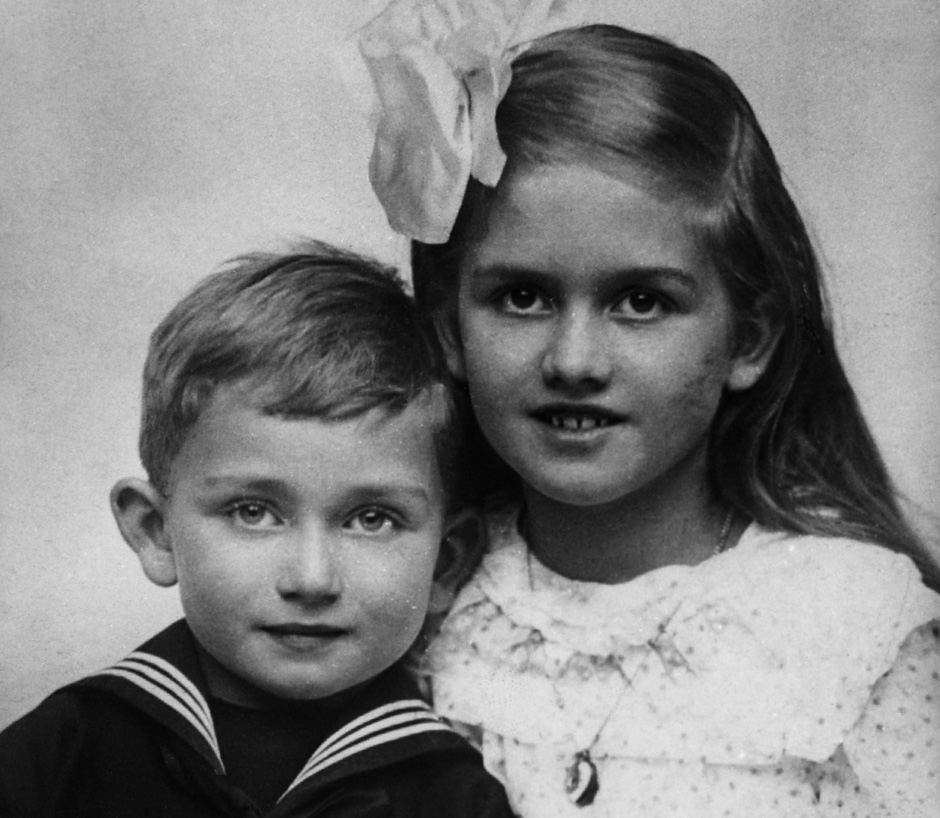
1917
1917 was an important year, because Ferdinand Porsche became the general manager of Austro-Daimler.
1922
In 1922, F. Porsche presented the Austro-Daimler Sascha, a small 4-cylinder racing car with a displacement of 1.1 litres. The car was designed for a wealthy Austrian count and film maker Sascha Kolowrat. At first go in the same year, “Sascha” snapped up first and second places in its category in the Targa Florio race in Sicily, Italy. “Gazetta dello Sport” commented on its success as follows: “Up until very recently no one would have dreamed it possible to achieve such top speeds and durability with a 4-cylinder engine belonging to the category of smallest cars ever.”
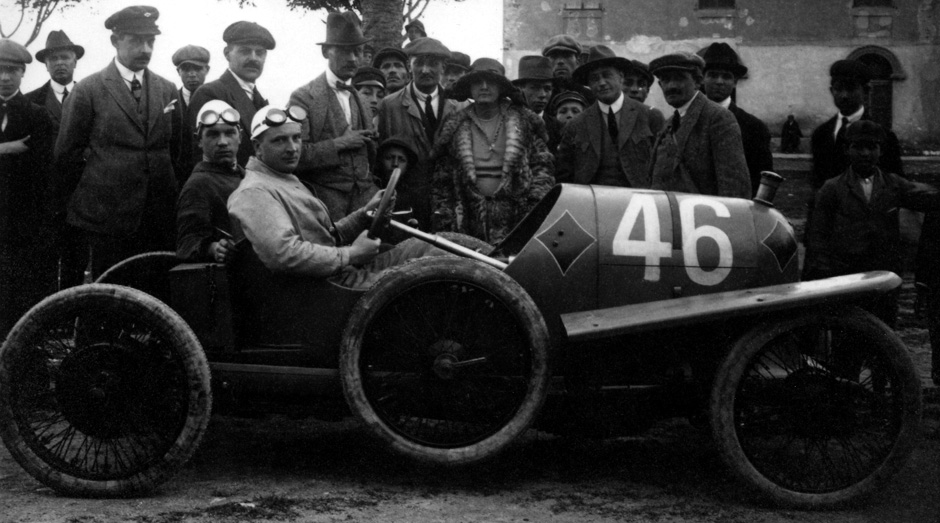
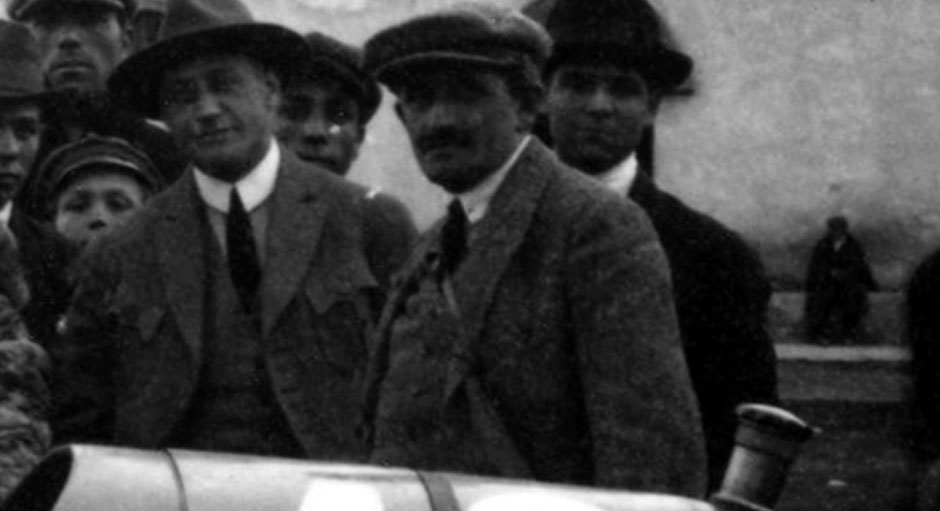
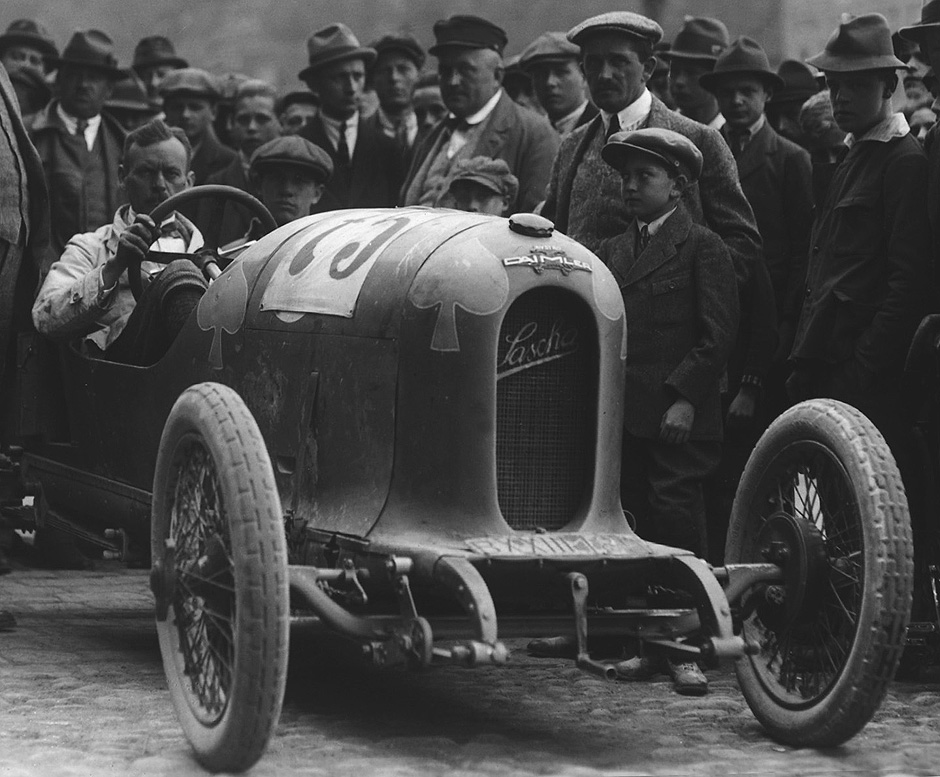
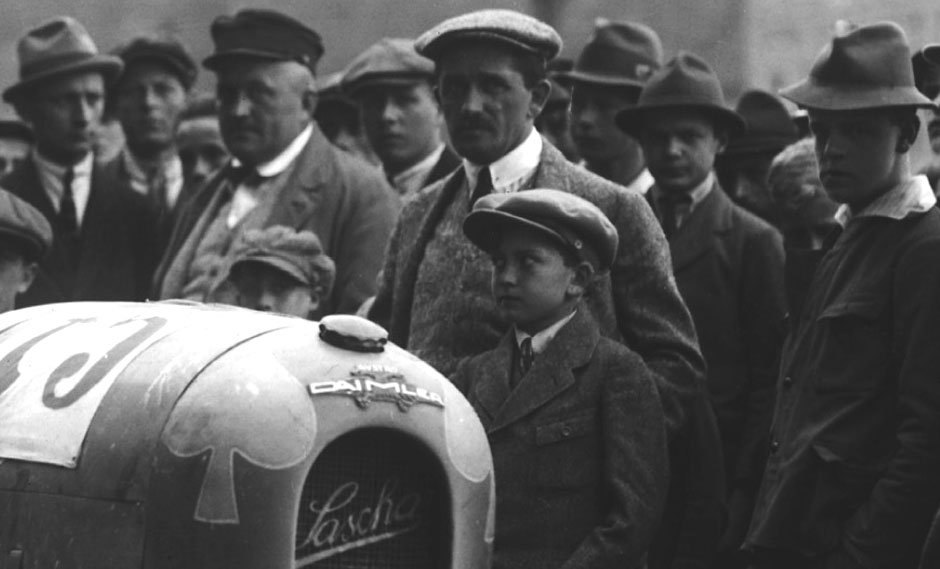

1923
1923 On April 30, F. Porsche joined Daimler-Motoren-Gesellschaft in Stuttgart as a technical director and an board member. Daimler and Benz companies merged the next year (and from 1926 started producing their cars under one brand – “Mercedes-Benz”).
1924
1924 On April 27, the Targa Florio race was won with the Mercedes PP (supercharged 2.0 inline-4) engineered by Porsche. Two years after the sensational success of Porsche’s Austro-Daimler Sascha, it was the turn of the Porsche’s Mercedes racing car to take first place against larger-engined cars entered by Alfa Romeo, Hispano-Suiza and Peugeot. The PP specs were as follows: 126 hp with supercharger engaged (68 hp without it), max rpm 4500, 4-speed transmission, length 3.8 m, weight 921 kg, top speed 120 km/h (75 mph). Following the win of the 1924 Targa Florio, the Stuttgart Institute of Technology (Technische Hochschule) conferred the honorary title of “Dr. Ing.” on Ferdinand Porsche.
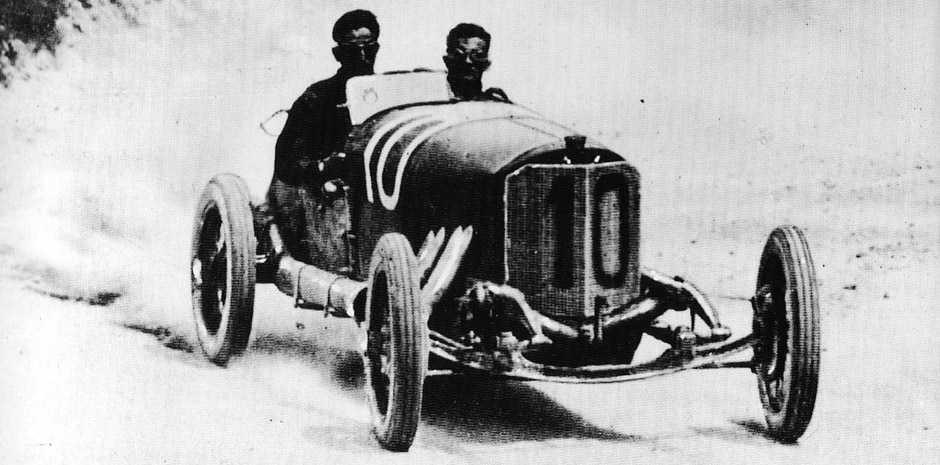
The length of the race was 432 km (4 laps of 108 km). 37 cars started. Contrary to the regulations on the colouring of racing cars according to their nationality, this car was painted red instead of white – reportedly this was meant to stop spectators from recognizing the car as a competitor’s car and throwing stones at it, a common practice at the time.
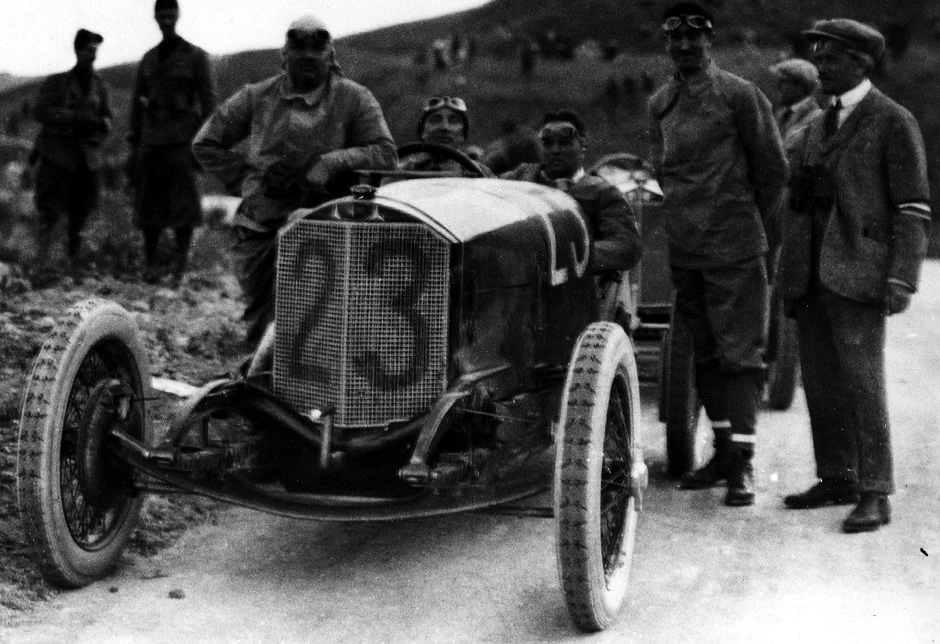
Mercedes PP’s also came 10th driven by Christian Lautenschlager and 15th driven by Alfred Neubauer. In this photo Alfred Neubauer is at the wheel. He moved from Austro-Daimler to Daimler-Motoren-Gesellschaft in Stuttgart-Untertürkheim two months after Ferdinand Porsche and in the 1930s and 1950s he was Daimler-Benz’s racing manager.

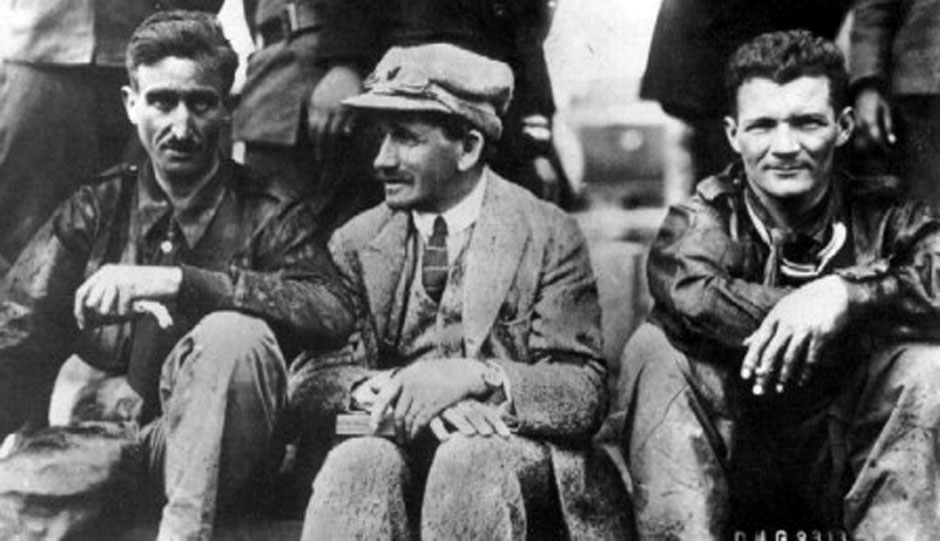
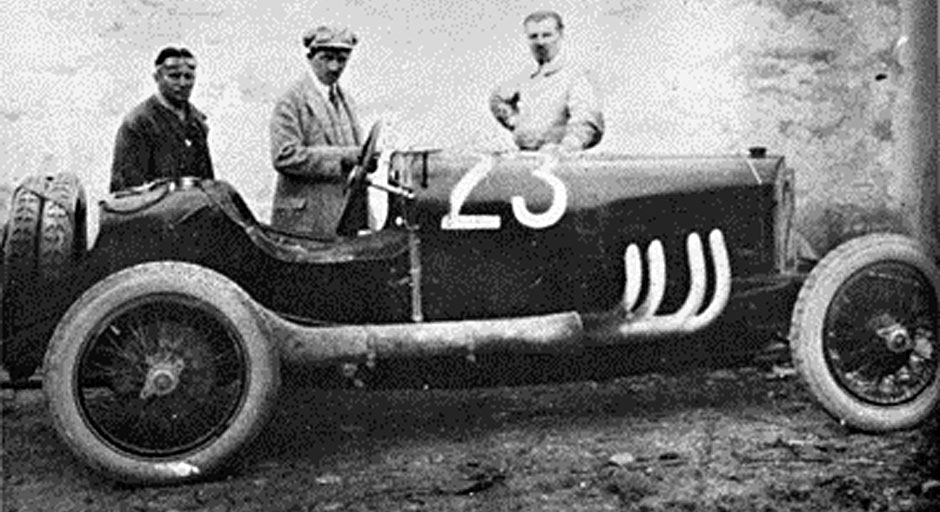
The same year, 1924, saw the introduction of the new racing car designed by Porsche, the Mercedes Monza. It was the first 8-cylinder Mercedes racer and had the following specifications: supercharged 2-litre inline-8, 170 hp @ 7000 rpm, 3-speed transmission, 94 litre fuel tank, 780 kg/1720 lbs, 180 km/h (112 mph).
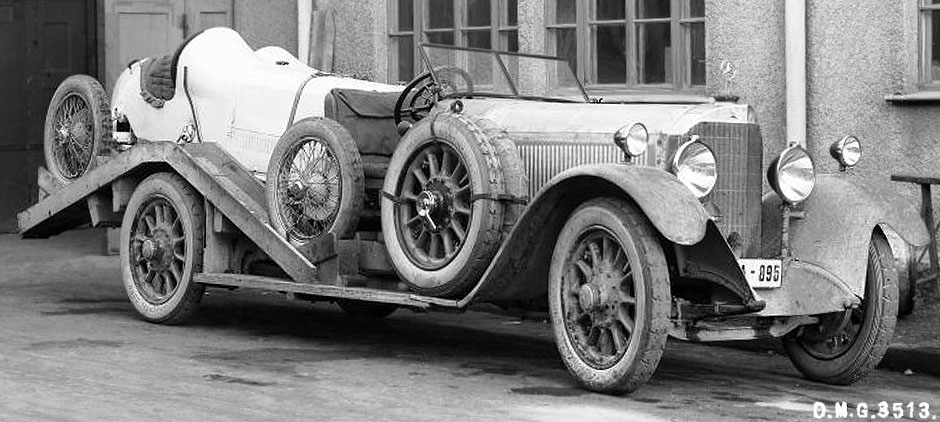
Mercedes Monza on the 1924 Mercedes race car transporter. It had been Alfred Neubauer’s and Christian Werner’s idea not to use racing cars for the journey to the races. So, with the 1924 Monza race, it was the first time the racing cars were carried to the race and not driven there.
1925
In 1925, Mercedes 24/100/140 K, a heavy touring car was developed for racing purposes. Specs: supercharged 6.2-litre inline-6, 118 kW, 4-speed transmission, 110 litre fuel tank, 155 km/h (96 mph).
1926
In 1926, on June 28, Daimler-Motoren-Gesellschaft and Benz & Cie. merged to form Daimler-Benz AG. At the 1926 German GP at Avus, Rudolf Caracciola wins with Porsche designed Mercedes Monza with average speed of 135 km/h (84 mph) over the 392 km (244 mile) total distance of 20 laps. The other Mercedes, driven by Adolf Rosenberger, crashed into the timekeepers’ box killing 3 persons. Five years later Rosenberger would become the founding member of the Porsche company.
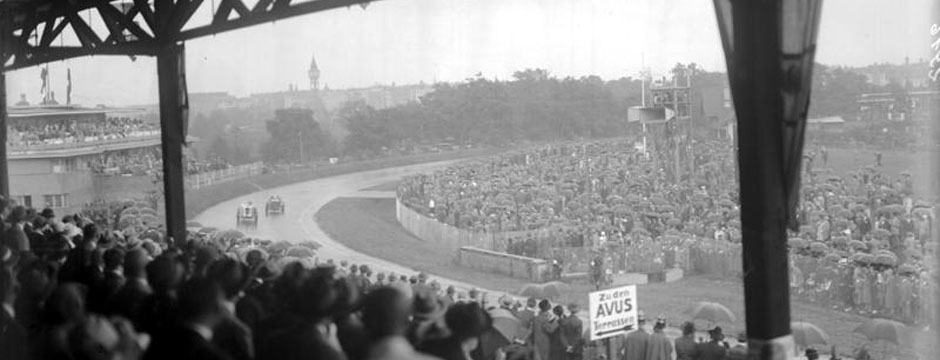
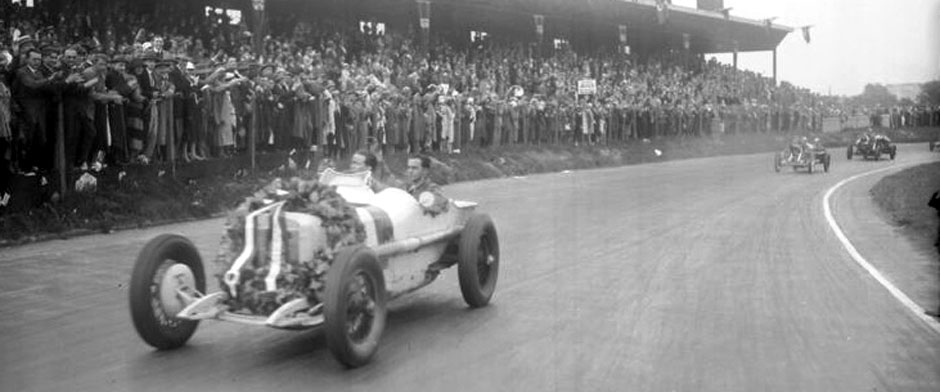
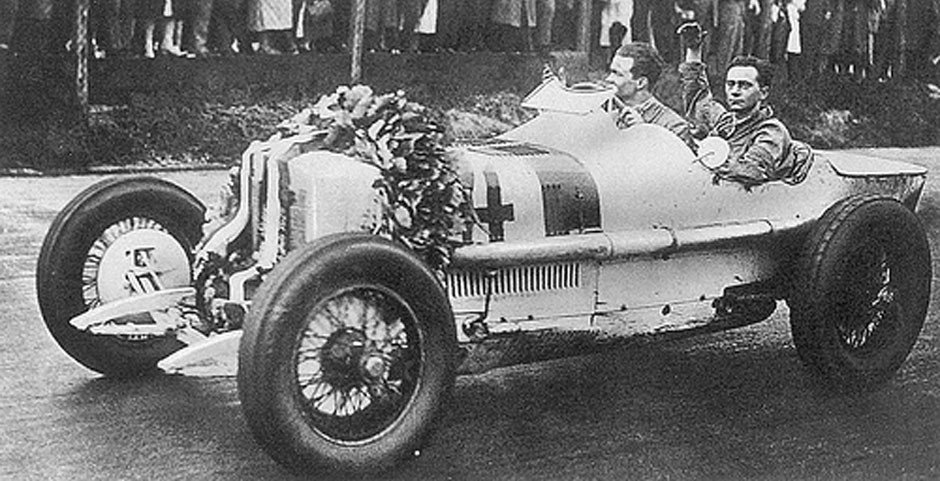
1927
On June 19, 1927, Mercedes-Benz 26/120/180 S-model cars entered the German Grand Prix, the first race on the new Nürburg-ring, and finished 1st, 2nd and 3rd. Caracciola took the victory.

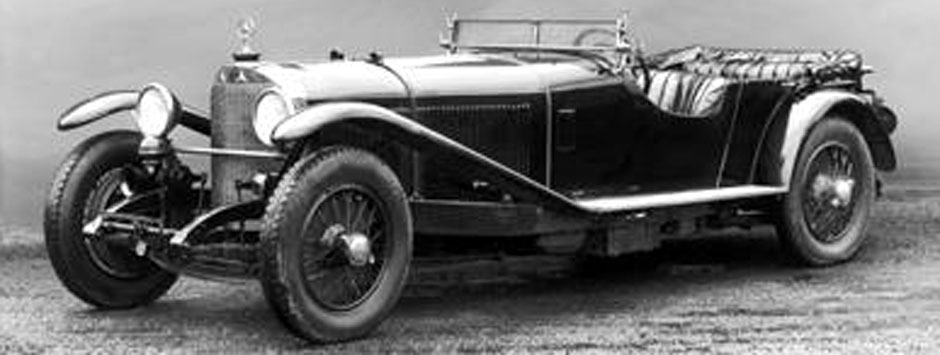
1928
On July 15, 1928, the German GP at the Nürburg-ring saw Mercedes-Benz 1-2-3 victory again. Rudolf Caracciola / Christian Werner took the win in a Mercedes-Benz 27/140/200 “SS”. This was a more powerful version of the “S”. It had a 7.1-litre engine producing 147 kW and a top speed of 170 km/h (106 mph). “SS” standed for “SuperSports”. In 1928, also the SSK (“SuperSports Kurz”), the short version of the SS was introduced with an output of 184 kW from the same 7.1-litre engine and with a top speed of 192 km/h (119 mph). On October 4, the Mercedes-Benz “Nürburg” 460 (18/80 hp), the first Mercedes-Benz production car with an 8-cylinder inline engine, was launched at the Paris Motor Show. Dr. Porsche left Daimler-Benz at the end of the year.
1929
In 1929, Dr. Porsche took up the position of Technical Manager at Steyr-Werke AG in Austria. Grandson Ernst Piėch was born.
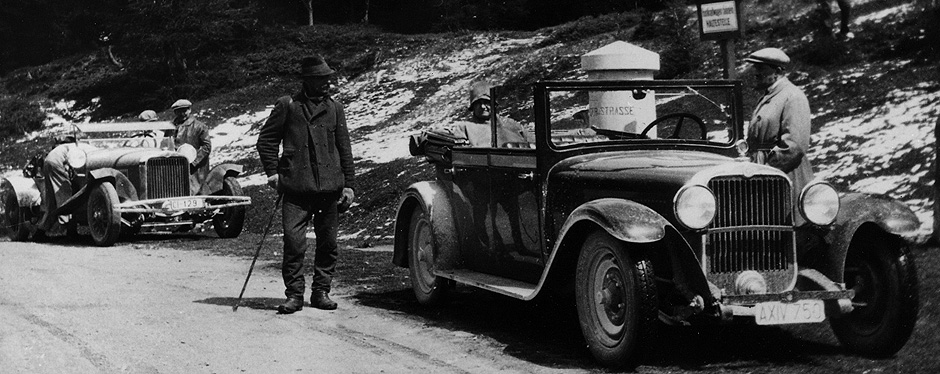
1931
1931 On January 1, rental agreement started for Porsche’s own design office at Kronenstrasse 24, in the center of Stuttgart (Ferdinand Porsche had actually moved in already in December 1930). The company was officially registered a few months later.
On April 25, 1931, at the age of 55, Ferdinand Porsche finally registered his own company. It was recorded in the Commercial Register as “Dr. Ing. h. c. F. Porsche GmbH, Konstruktionen und Beratung für Motoren- und Fahrzeugbau” (Dr. Ing. h.c. F. Porsche LLC, Design and Consultancy Company for Engine and Vehicle Production). The company was co-founded by Dr. Anton Piëch (10%) and racing driver Adolf Rosenberger (10%).
Following the establishment of the company, on August 10, 1931, the torsion bar suspension was registered for a patent. It is said that this alone would have sufficed to commemorate the Porsche name in the automobile world.
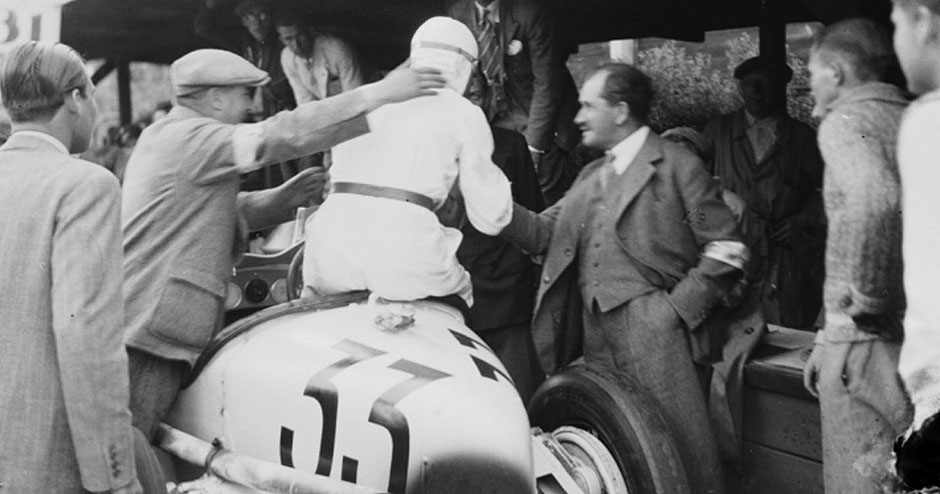
1932
In 1932, Granddaughter Louise Piėch (Daxer) was born. Porsche was contracted by Wanderer to design a supercharged 16-cylinder Grand Prix racing car for the new 750 kg-formula. The same year Wanderer, DKW, Audi and Horch all had financial difficulties and the biggest amounts they owed to Bank of Saxony, which then merged all the brands into one company called the Auto Union. The new company got a logo with four rings (and although only one of these rings symbolized Audi, by the end of 1960’s the 4 ring logo became an Audi logo). On November 8, 1932, Porsche founded a special company called the Hochleistungs-Fahrzeug-Bau G.m.b.H. (High Performance Vehicle Manufacturing Ltd.) with its location also at Kronenstrasse 24. The company was founded solely for the purpose of designing the Porsche Type 22 Auto-Union GP race car. The Auto Union P-wagen (P-car, Porsche-car) later won 32 races out of 64, and drivers such as Hans Stuck and Bernd Rosemeyer set many world records in them.
In 1932 Porsche also visited the Soviet Union at the request of Josef Stalin, who offered him a post as chief construction director, complete with generous compensation, a villa, and the transfer of his entire Stuttgart staff. He was also promised unlimited development funds to build a small car. Porsche, who still loved to race his own cars on the race tracks, declined the offer since the European Grand Prix did not extend to Soviet Union.
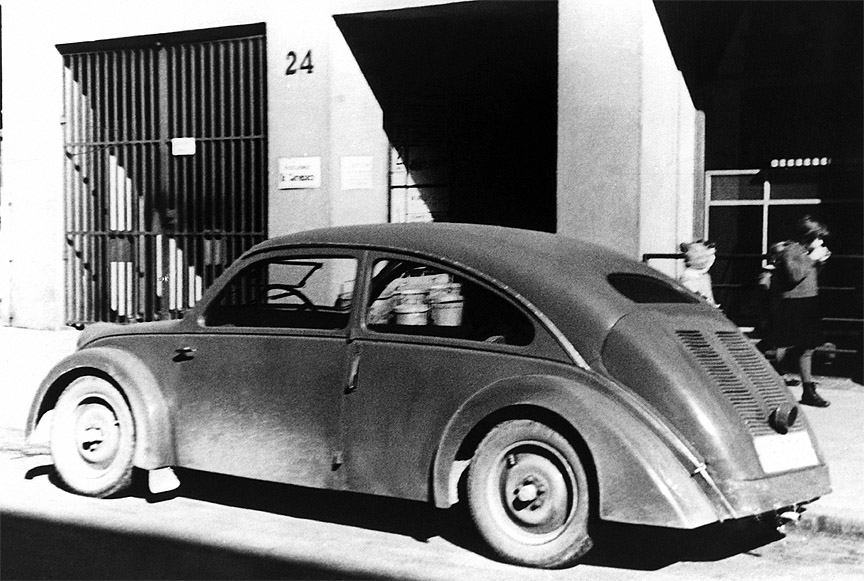
1934
In 1934, a contract was concluded between the Porsche design office and the Reichsverband der Automobilindustrie – the idea of Volkswagen was born. In the following period, Ferdinand Porsche was one of the general managers of Volkswagen GmbH.
In 1934, the supercharged 16-cylinder Auto Union racing car (Porsche Type 22) was born. The “750-kilogram formula” imposed no restrictions on the car’s design apart from a maximum weight limit of 750 kg. Despite Porsche company founder Adolf Rosenberger’s contribution to the development of German automobiles and German auto racing when Hitler came to power, Rosenberger, a Jew, was arrested and forced to leave Germany. He emigrated and represented Porsche GmbH in France and later in Great Britain.
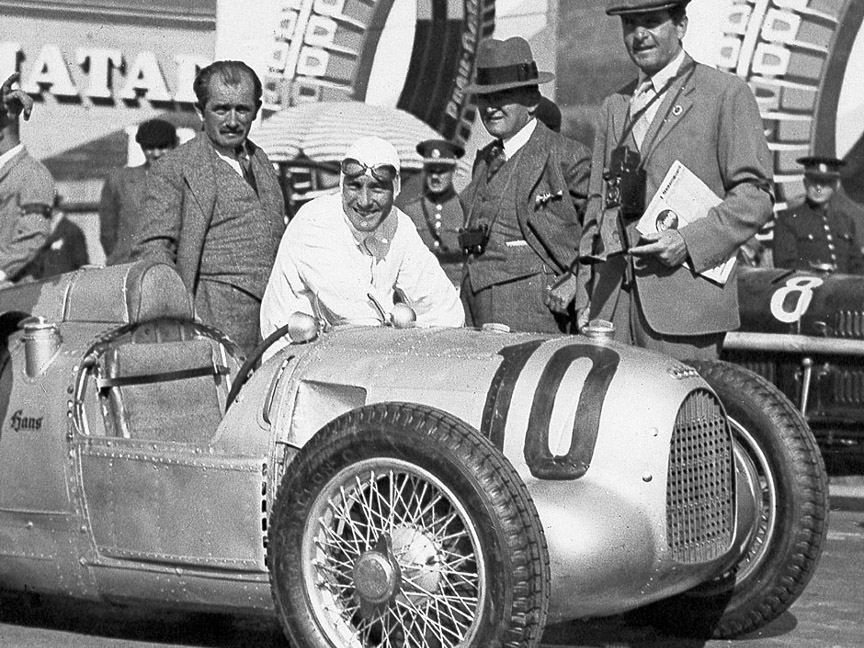
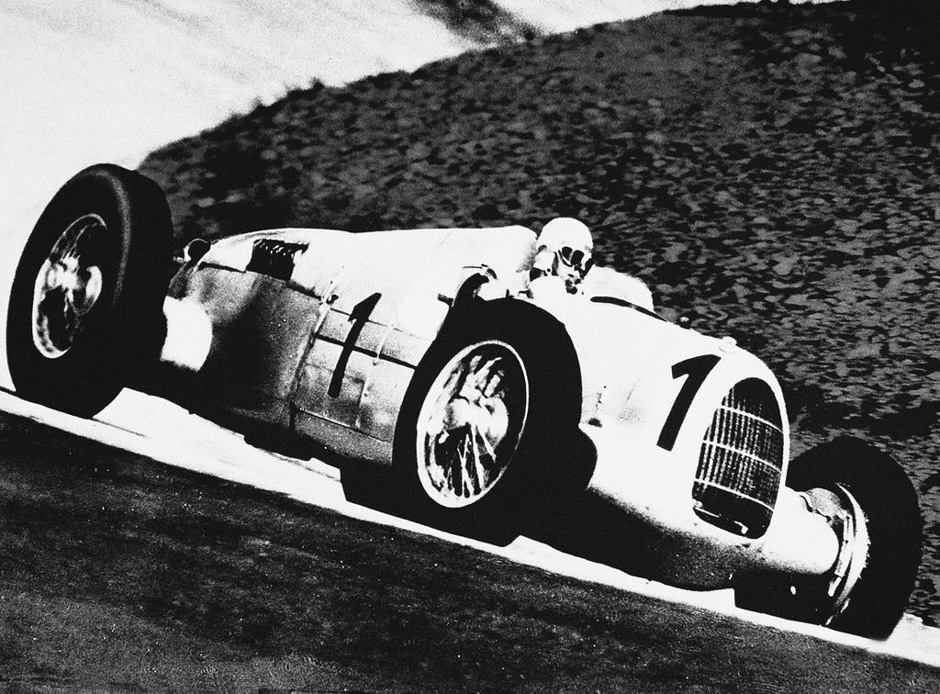
1935
1935 On December 11, grandson Ferdinand Alexander Porsche was born.

1936
In 1936, F. Porsche received the Wilhelm Exner Medal for excellence in research and science. On October 3, F. Porsche together with his nephew and private secretary Ghislaine Kaes started their voyage to USA onboard of the SS Bremen. Porsche wanted to study American automobile manufacturing in order to gather information for the Volkswagen plant.
SS Bremen started its voyage on October 2, 1936, from Bremen. Its first stop was in Southampton, England. Before heading to the Atlantic Ocean, the ship stopped in Cherbourg, France. F. Porsche and G. Kaes stepped on board there on October 3. The passenger list from October 3, 1936, tells us that Ferdinand Porsche lived at Feuerbacherweg 48, Stuttgart, was 5’8″ (172-173 cm) tall, had gray hair and blue eyes. Below is a concentrated information from that list:

While for the whole world Porsche was a constructor, for the SS Bremen he had become a “conductor”

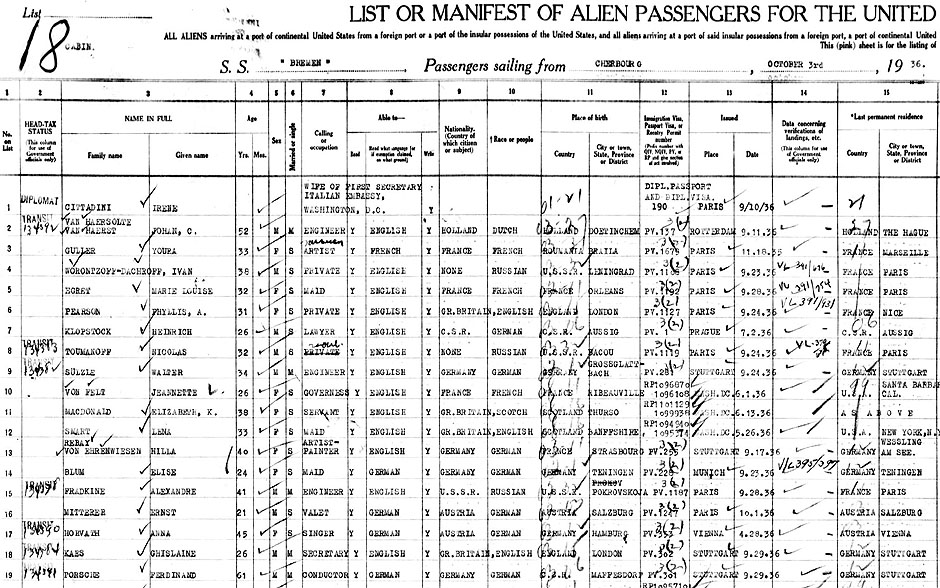
SS Bremen passenger list from October 3, 1936, showing Kaes Ghislaine and Porsche Ferdinand. Other prominent persons on board of SS Bremen between October 2-8, 1936, included electrical engineer Max Knoll, aeronautical engineer Frank Caldwell, aviator William Douglas Stock Sanday, racing driver and one of the founders of Squire car company Gerard Francis Anthony “Jock” Manby-Colegrave, engineer Ernst Grob, son of bakelite inventor George Baekeland, astronomer Joseph Helffrich, architect John Russell Pope, Telefunken director Hermann Behner, industrialist Richard Merton, Prince of Sayn-Wittgenstein-Berleburg, Swedish prince Sigvard Bernadotte, novelist Johanna van Ammers-Küller, violin virtuoso and composer Fritz Kreisler, conductor, pianist and composer Wilfrid Pelletier, physicist August Karolus, industrialist Frank Vlchek, banker Rudopl Hermann Kissel, American tobacco heiress Mary French Stephenson (wife of spy William Stephenson, a role model for James Bond), screenwriter Edwin Blum (“The New Adventures of Tarzan”, 1935), writer and musician Albert Morris Babgy, first American business woman and Coca-Cola board member Letitia Pate Whitehead Evans, writer Ernest Pascal, pianist Youra Guller, painter and Guggenheim Museum co-founder Hilla Rebay von Ehrenwiesen, world’s biggest media magnate’s wife Millicent Hearst, Broadway producer Gertrude Macy, Titanic survivor and White House music teacher Marie Grice Young.
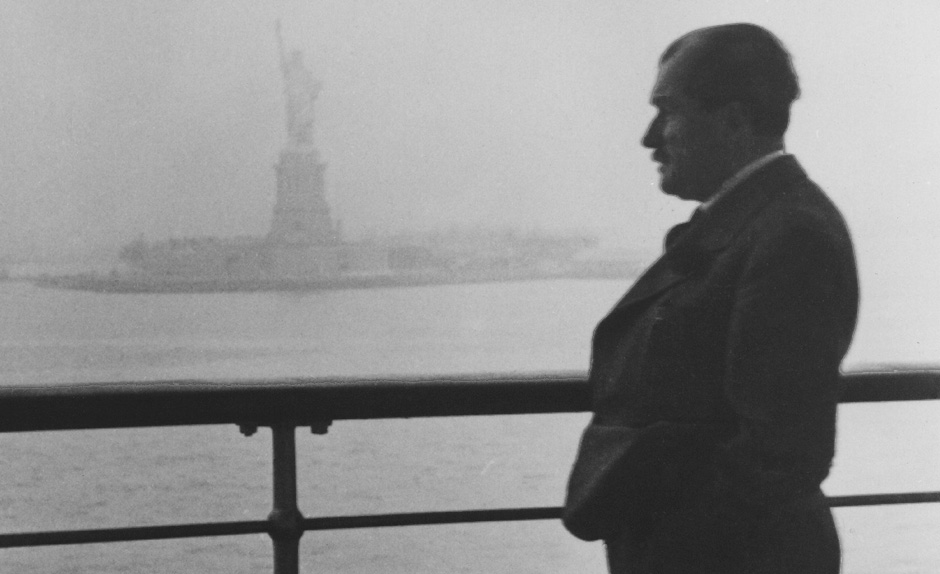
With about 2000 souls onboard, the ship docked in New York on October 8. Porsche visited various car factories in USA and familiarized himself with the latest production methods. He returned to Europe in November (?) on Queen Mary.
1937
On April 17, 1937, grandson Ferdinand Karl Piėch was born. In June, F. Porsche made his second US visit together with his son Ferry and secretary G. Kaes. Estonian car magazine “Auto” 3/4-1937 wrote: “People’s car (Volkswagen) is a headache! Dr. Porsche, the constructor of the Auto-Union racing cars, said that it is easier to build 10 racing cars than 1 people’s car.”
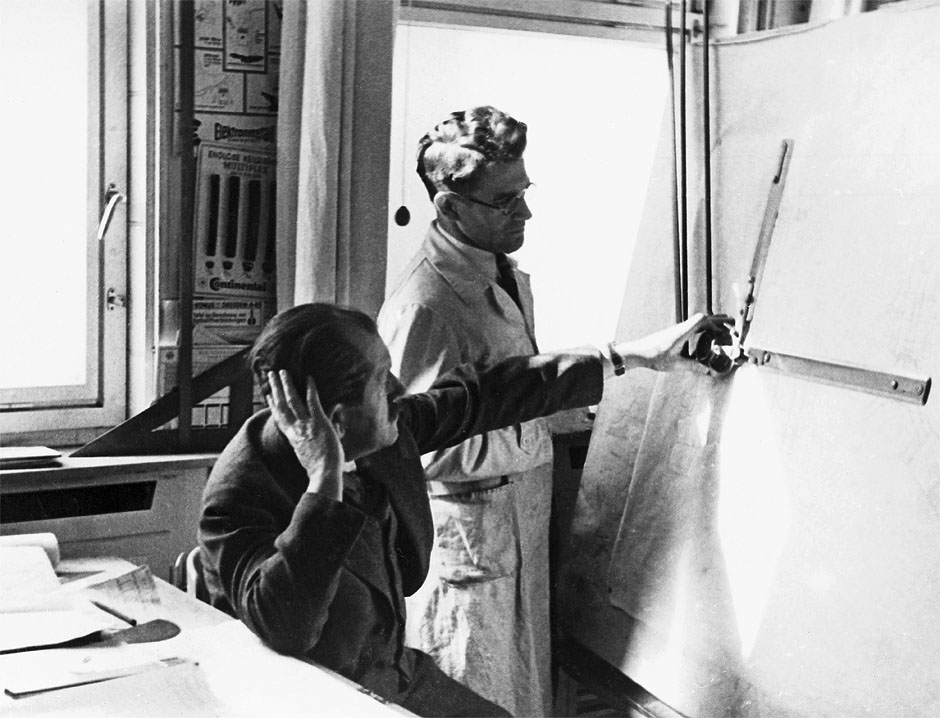
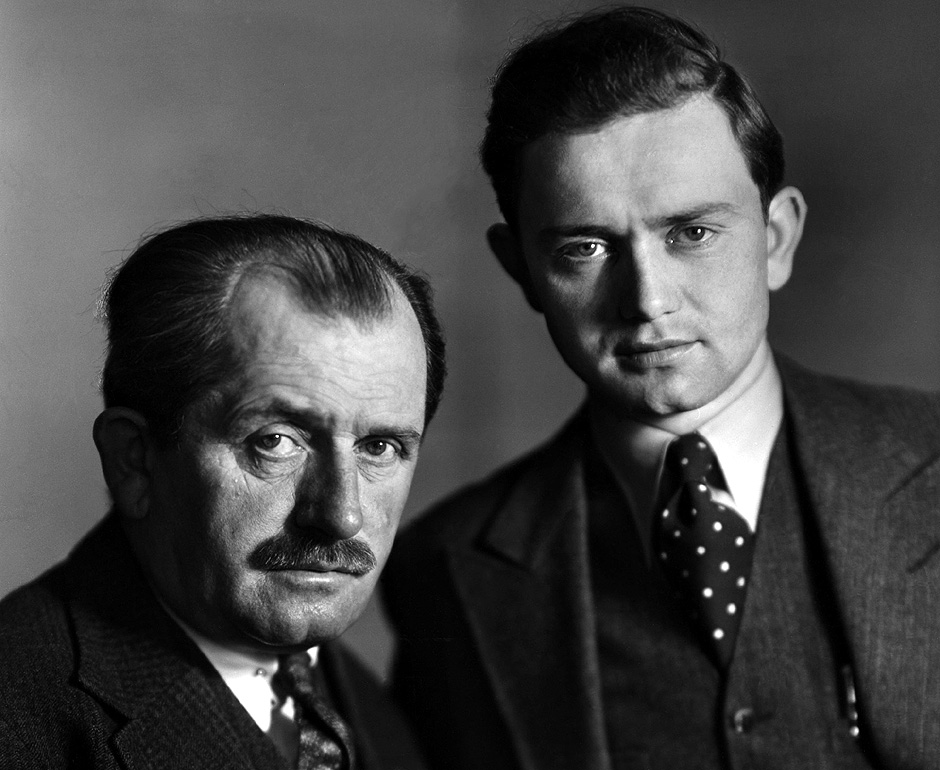
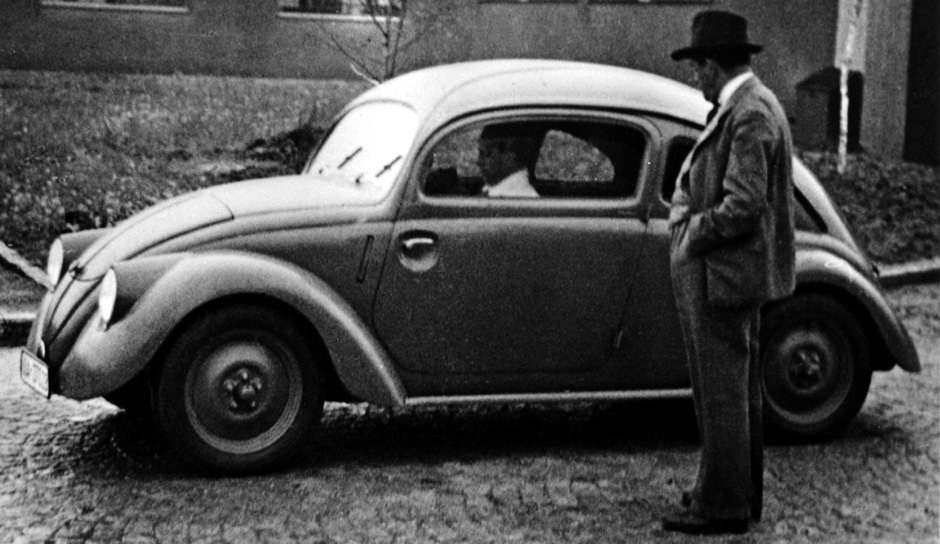
This car already had an all-steel body, steel running-gear components and the flat-four four-stroke engine. The first of this series of cars, like all the previous prototypes, was built in the double garage of Porsche’s villa in Stuttgart. The remaining 29 cars were built by Daimler-Benz in Stuttgart-Untertürkheim.
In 1937, the German Armaments Ministry issued a specification for a heavy tank to Daimler-Benz, Henschel, MAN and Porsche. The same year also the Mercedes-Benz T80 (Porsche Type 80) land speed record car project was started backed by the funds from the state, Dr. Porsche’s ingenious ideas, aerodynamics specialist Josef Mikcl and driver Hans Stuck. Porsche first targeted a speed of 550 km/h (342 mph), but later the target was raised.

1938
In 1938, although Adolf Hitler discussed the possibility of military application of the Volkswagen with Ferdinand Porsche as early as April 1934, it wasn’t until January 1938 that high-ranking Third Reich army officials formally approached Porsche with this plan. They wanted Porsche to design an inexpensive, light-weight military transport vehicle that could be operated reliably both on- and off-road in even the most extreme conditions, suggesting that the Beetle could provide the basis for such a vehicle. In May 1938, the construction of the Volkswagen Kübelwagen prototype (Porsche Type 82) started and 16 months later, pre-production models were field-tested in the invasion of Poland in September 1939.
Estonian “Auto” magazine 5/1938 wrote that the KdF-wagen (Volkswagen) factory construction started in May 1938 and after it will be finished, 50.000 workers will be hired. The article wrote that no other car in the world had passed so many and so long tests as Dr. Porsche’s people’s car. Initial information said, the car will weigh only 650 kg, will consume 6-7 litres of fuel on 100 km and standard color will be dark blue. Acceleration 0-70 km/h was promised in 14 seconds which was comparable to the cars with larger engines.
F. Porsche’s grandson Gerhard Anton Porsche was born on June 5, 1938. While at the end of 1931 Porsche engineering company had around 20 employees, the number had rosen to around 200 by 1938. At the end of June, Porsche company moved to a new purpose-built building in Zuffenhausen, just 7 kilometres away. At that time the address was Spitalwaldstraße 2. Later the building became known as Porsche Werk 1.
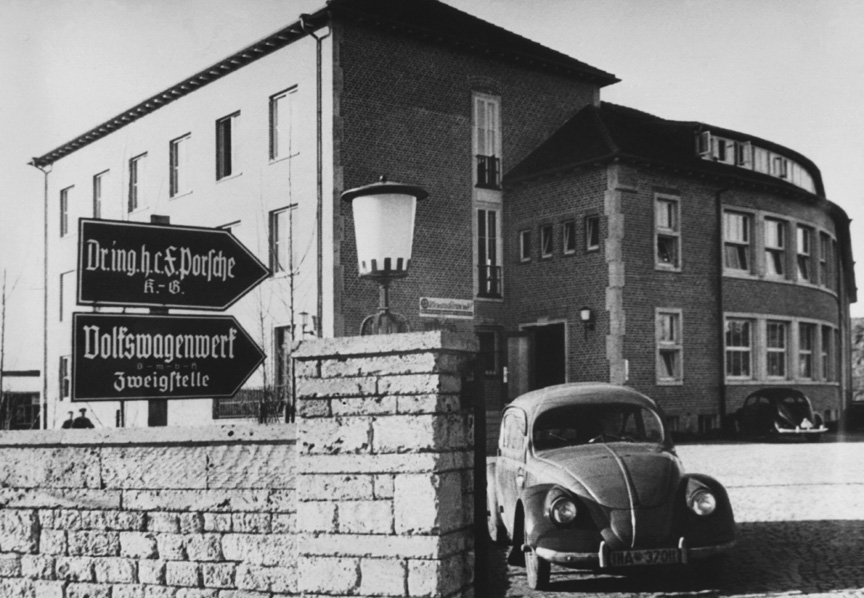
The purpose-built headquarters for Porsche company in Zuffenhausen, later known as Porsche Werk 1. As can be seen from the upper sign the company was changed from GmbH (Gesellschaft mit beschränkter Haftung, limited liability company) to KG (Kommanditgesellschaft, limited partnership business) and as can be seen from the lower sign, space was rented also for Volkswagenwerk Zweigstelle (a branch office of Volkswagen).
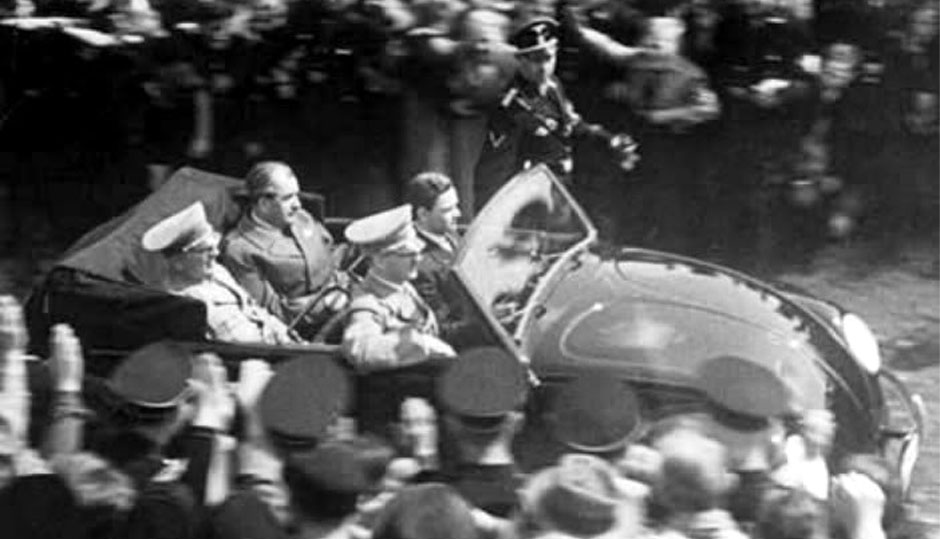
Above is a photo of Robert Ley (head of KdF), Ferdinand Porsche and Adolf Hitler driven by Ferry Porsche. The persons sitting on the right seem happy and the persons sitting on the left – not. Porsche got money from Hitler to build the racing cars and the Beetle, but now he “had to” design also the military equipment.
1939
In 1939, a Berlin-Rome road race was scheduled for September, but it didn’t happen due to the outbreak of WWII. Porsche had already engineered and built a KdF racing car (Porsche type 64).
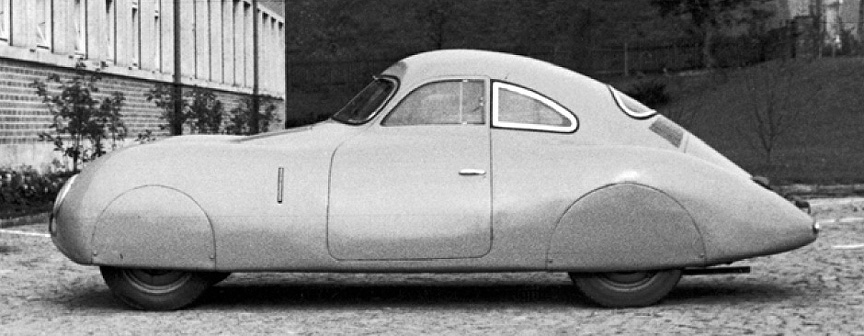
The first type 64 in front of the Porsche villa in Stuttgart is shown above. The type 64 was the grandfather of all Porsche sports cars to come.
By late 1939, the Mercedes/Porsche land speed record car T80 was also finished – now with the targeted top speed of 750 km/h (466 mph) – but the record attempt was cancelled due to the outbreak of the war. If the scheduled record attempt would have actually happened, Hans Stuck would have most probably died in January 1940 (and not in February 1978). A part of Berlin-Dessau autobahn was planned to use and it was only 25-27 m (83-90 feet) wide – imagine that at the projected top speed! In winter.

The T80 had a tuned Daimler-Benz aircraft engine. The inverted V12 (crank up, cylinders down) with 44 litres displacement developed 3000 hp. The engine ran on a mixture of 7 different chemicals. The streamlined body achieved a drag coefficient of an astonishing 0.18. Kurb weight: 2900 kg (6393 lbs). In 1939, the wished-for top speed was risen to 750 km/h! No car in the world with piston engine and wheel drive has ever reached 750 km/h.
The DB-603 aircraft engine was removed during the war while the vehicle was moved to safe storage in Kärnten, Austria (where Porsche had moved its company because of the war). The T80 survived the war and is now displayed in Mercedes-Benz Museum in Stuttgart.
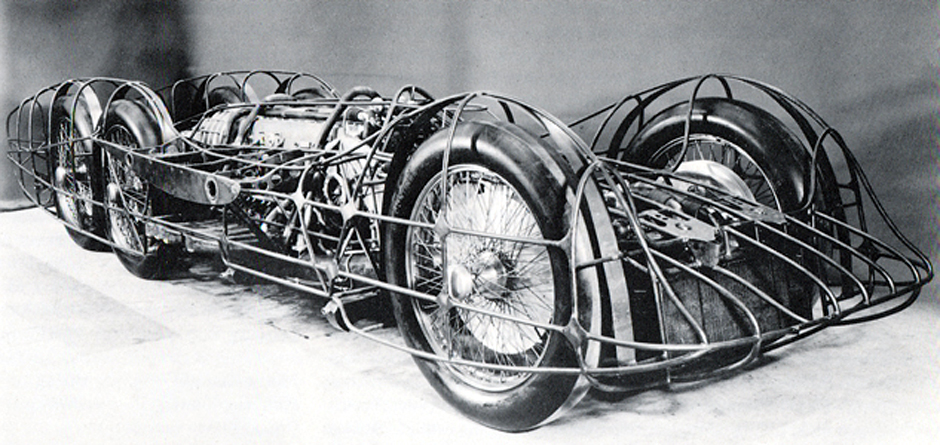
1940
On October 29, 1940, grandson Hans-Peter Porsche was born. On the same year, Ferdinand Porsche was conferred the honorary title of professor.
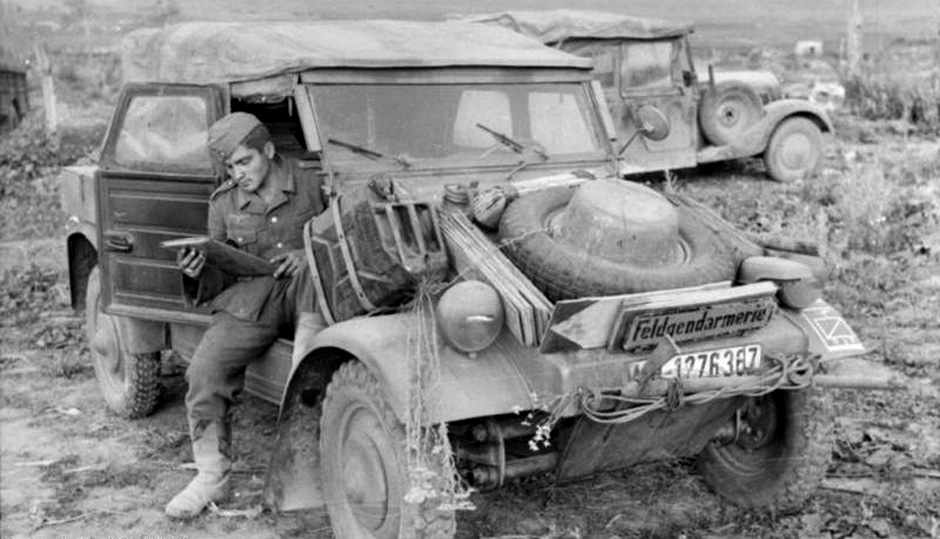
On May 26, Hitler ordered both Porsche and Henschel to supply their designs for a heavy tank. The project was known as the “Tigerprogram”. An interesting fact is that between 1940 and 1945, a total 50,435 Porsche designed VW Kübelwagens were made.

1941
Between 1941-1944 a total of 15.584 Type 166 Porsche designed VW Schwimmwagens were produced; 14.276 at the Volkswagen factory and 1308 by Porsche.
1942
On January 10 1942, grandson Hans-Michel Piėch was born.
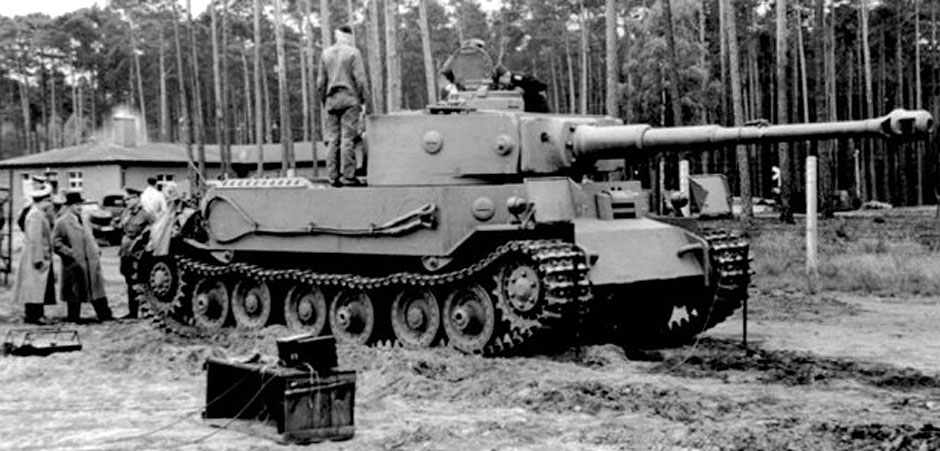
100 Tiger (P) tanks were ordered, but the order was cancelled in the beginning of the production and only a few were made. Only one Tiger P saw real war action in 1944. Over 1000 Tiger (H) – “H” for Henschel – were made between 1942-1944. F. Porsche can be seen on the photo.
1943
On May 10, 1943 grandson Wolfgang Porsche was born. Around 90 hulls that were left unused after the Tiger P tank production was terminated, were now used for the tank destroyer Tiger P Ferdinand (from 1944 called “Elefant”).
1944
1944 In autumn, Porsche’s design office was relocated 600 km from Stuttgart to Gmünd in Carinthia (Kärnten), Austria. Ferdinand Porsche lived in Gmünd and in Zell am See towards the end of the war.
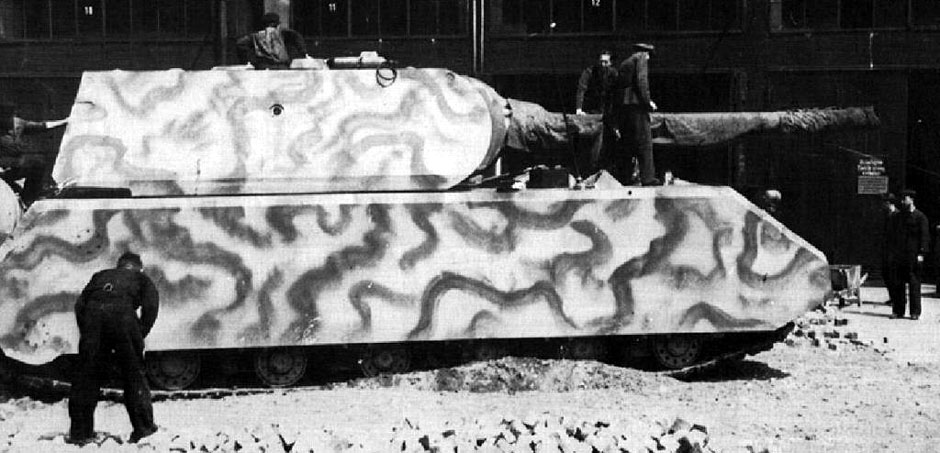
Porsche type 205 Panzerkampfwagen VIII “Maus” was a German WWII super-heavy tank completed in late 1944. With the weight of 188 tons, it is the heaviest fully enclosed armoured fighting vehicle ever built. Two prototypes were built, one of them functional. The latter got hit in the war. Later, Soviets merged the base from one tank and the top from the other and this new creation was taken to Russia where it is now in a tank museum.
1945
On September 2, 1945, World War II ended. In November, Porsche was contacted by French Army regarding possible contract work. On December 15, Ferdinand Porsche, Ferry Porsche, Anton Piëch and engineer Herbert Kaes went to Wolfsburg to meet the French. They were arrested and taken to jail in Baden-Baden, Germany.
1946
On May 3, 1946 the imprisonment in Baden-Baden, ends to be continued in France. Ferdinand Porsche, Ferry Porsche and Anton Piëch were taken to Paris. In July, Ferry was released, but Dr. Porsche and Dr. Piëch were still needed to collaborate on designs for Renault 4CV rear-engined family car. The prisoners were relocated from Paris to a medieval jail in Dijon.
1947
On August 1, 1947 Ferdinand Porsche and Anton Piëch were liberated after Ferry Porsche had paid the ransom. Upon Dr. Porsche’s return, he examined the design of the Cisitalia racing car (Porsche type 360), which was constructed under the management of his son and which brought the money for the bail out. After close observation, he came to the conclusion: “I would have built it exactly the same way, right down to the last screw”. French court later found F. Porsche not guilty in the war crimes.
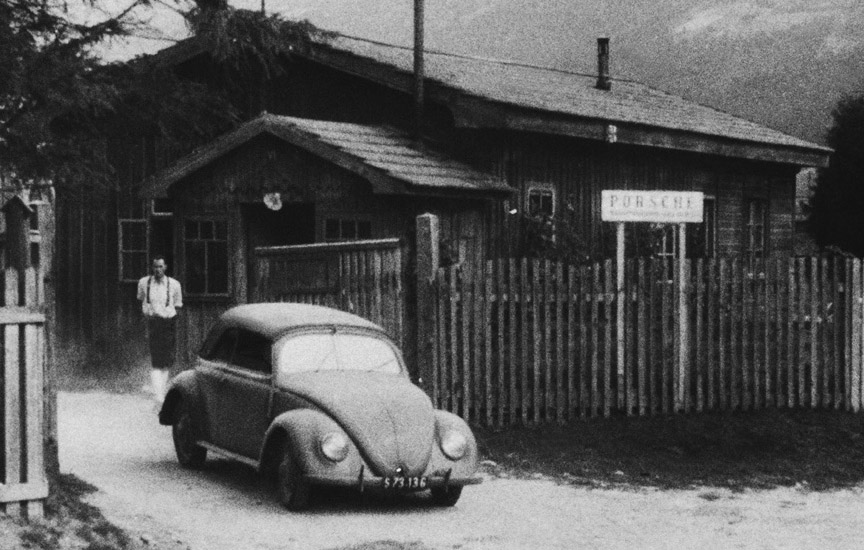
1948
On June 8, 1948, the first Porsche 356 was road registered. The 356 no.1 was a mid-engined tubular steel frame roadster with aerodynamic aluminium body constructed under the management of dr. Porsche’s son Ferry Porsche. Only one month later, the lightweight mid-engined roadster scored its first class victory at the Innsbruck Stadtrennen (city race).
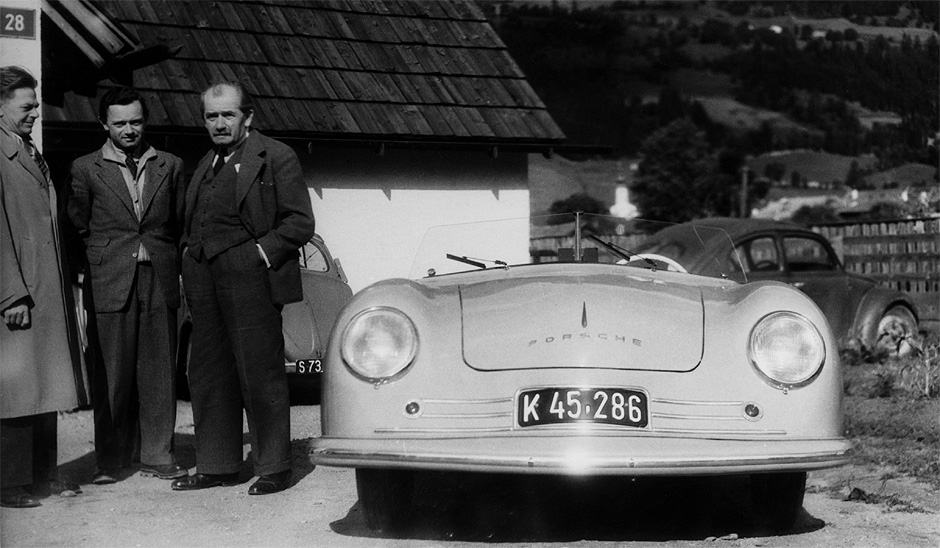
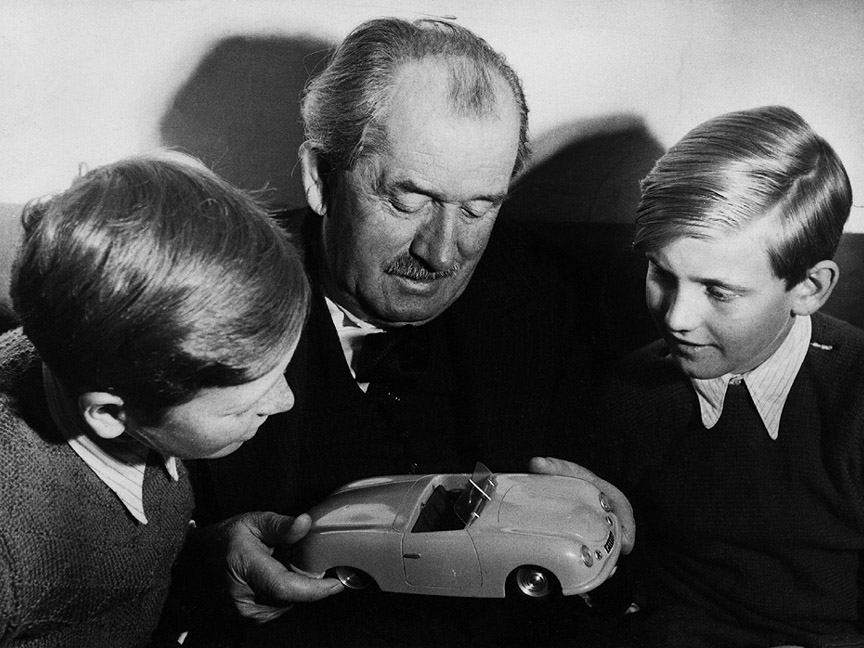
1950
On April 6, 1950 the first Porsche 356 was produced in the new factory in Stuttgart.
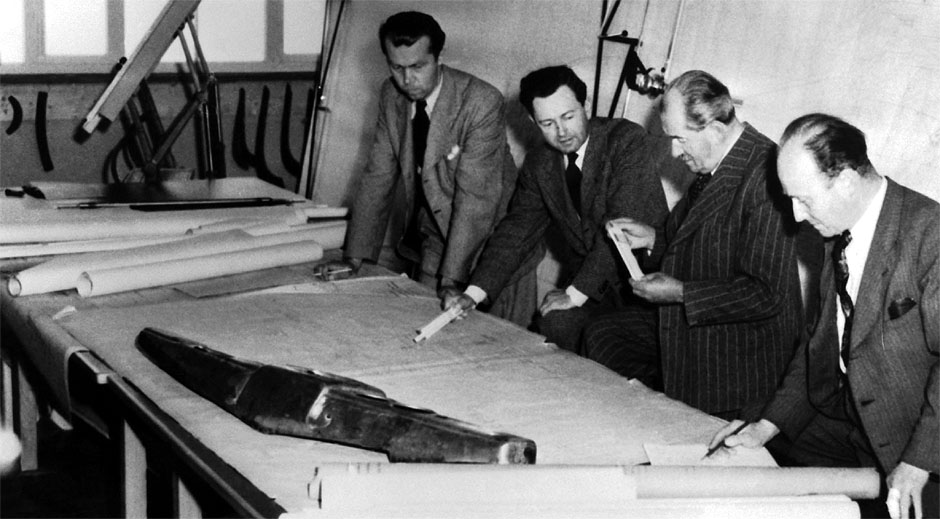
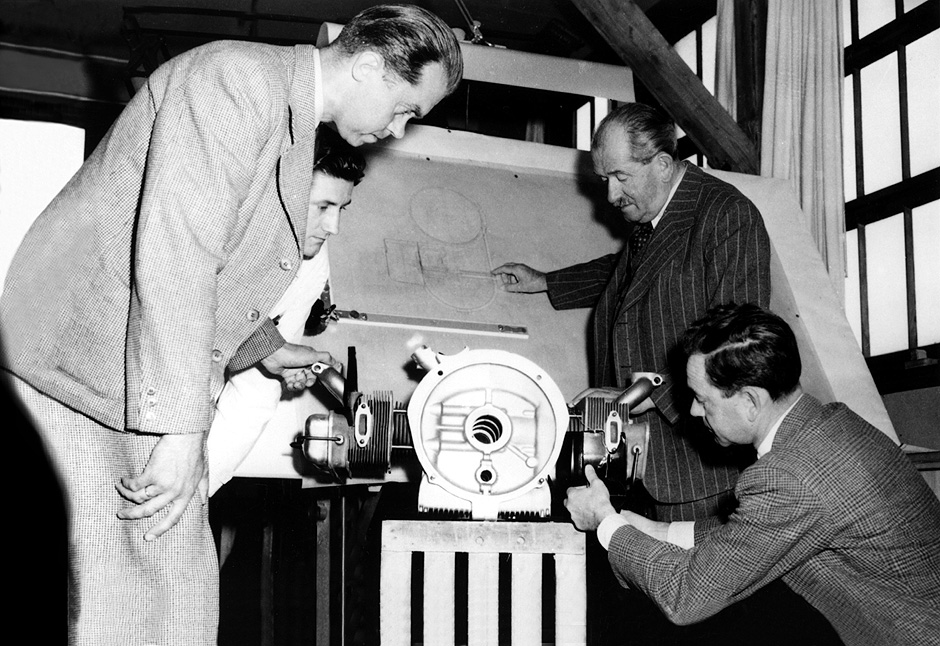
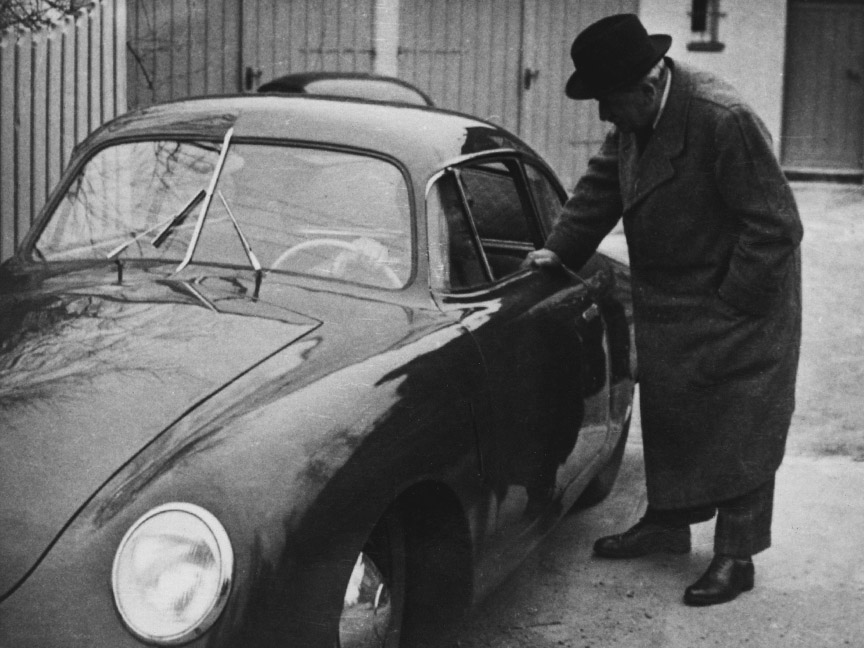
1950. Ferdinand Porsche with Karl Rabe, who was Porsche’s chief designer from the establishment of the Porsche company in 1931 until his retirement at the end of 1965. Rabe worked for Austro-Daimler with Ferdinand Porsche from 1913 on, where he became design office manager in 1923 after Porsche’s move to Daimler-Motoren-Gesellschaft. In 1929, when Ferdinand Porsche joined the Steyr-Werke, he encountered Karl Rabe, again, who had been deputy head of design there since 1927. From then on, the careers of Karl Rabe and Ferdinand Porsche remained closely linked.© Porsche
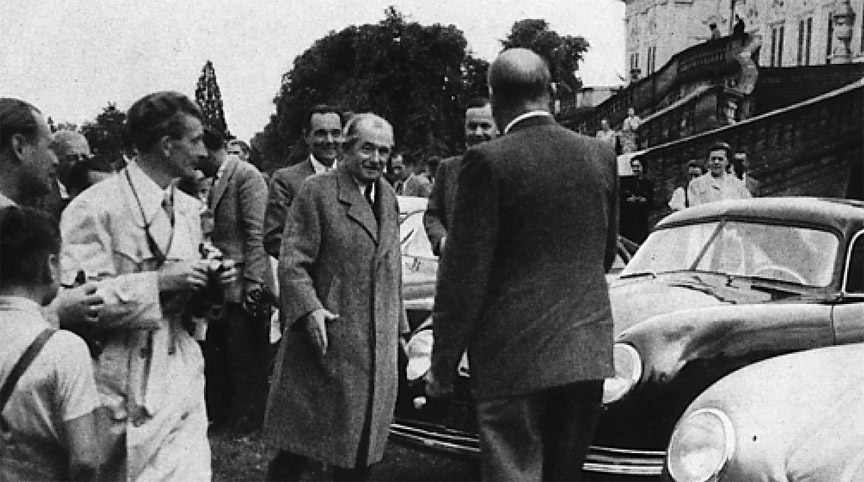
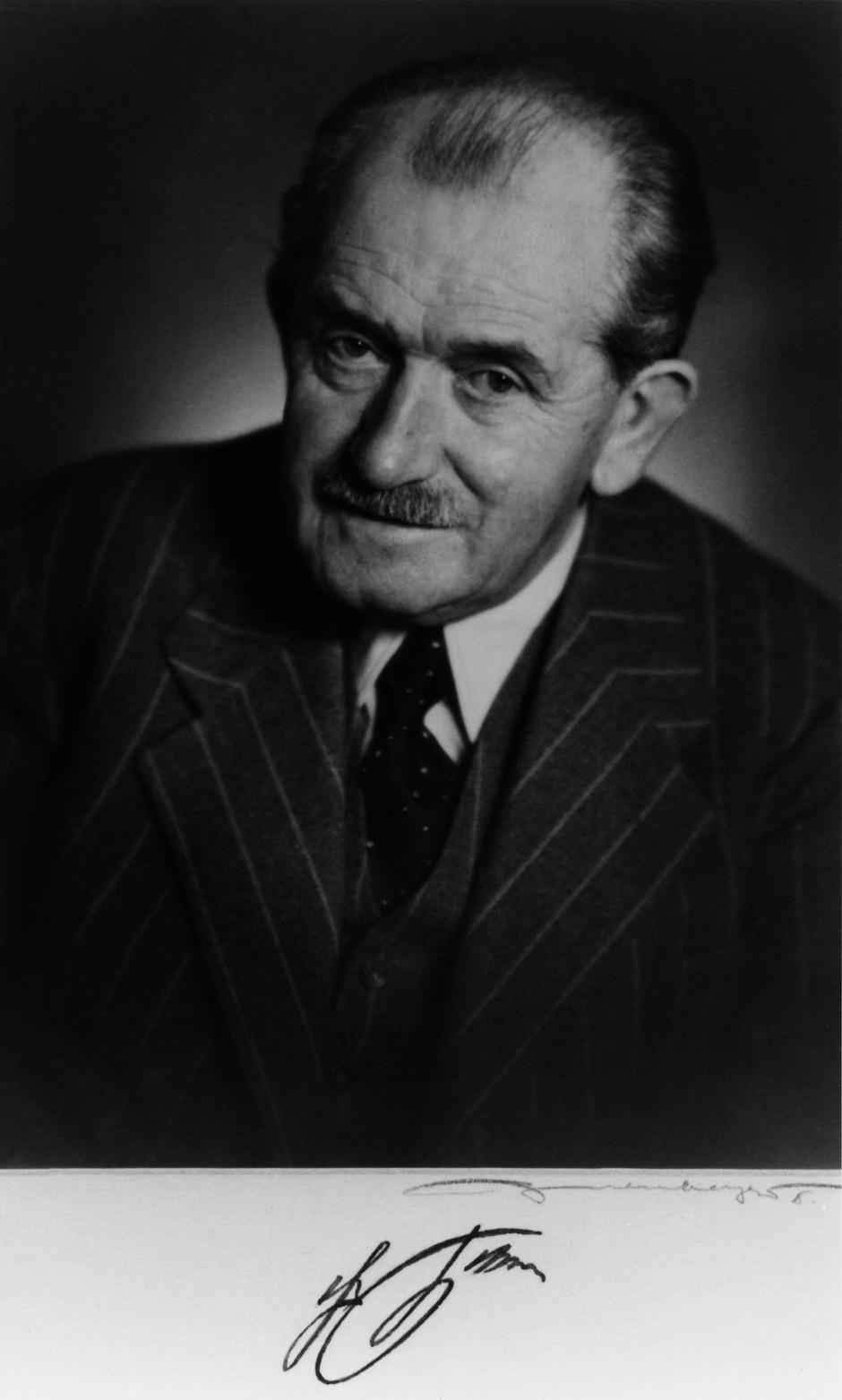

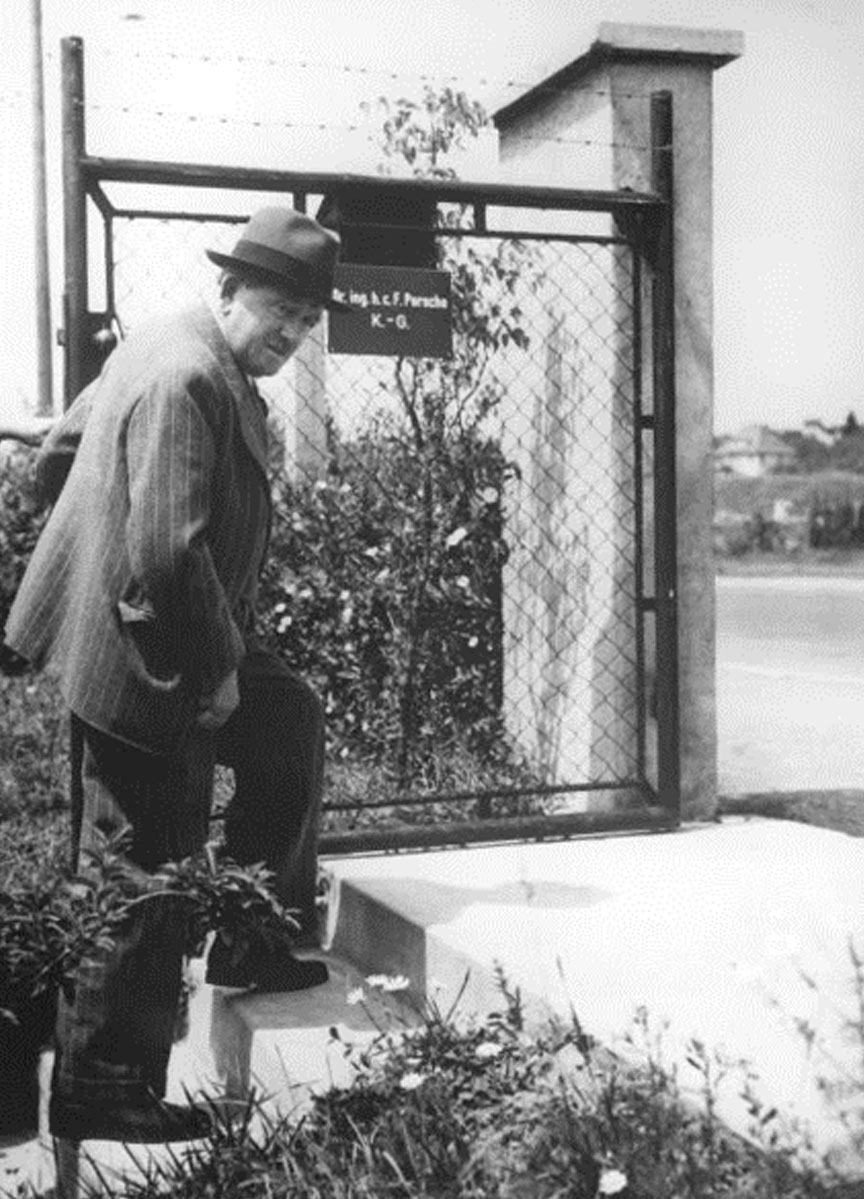
1951
1951 On January 30, at the age of 75, Ferdinand Porsche died in Stuttgart. He didn’t recover from the stroke he suffered in November 1950. He is laid to rest in chapel in the family estate “Schüttgut” in Zell am See in Austria.

Article © Stuttcars.com



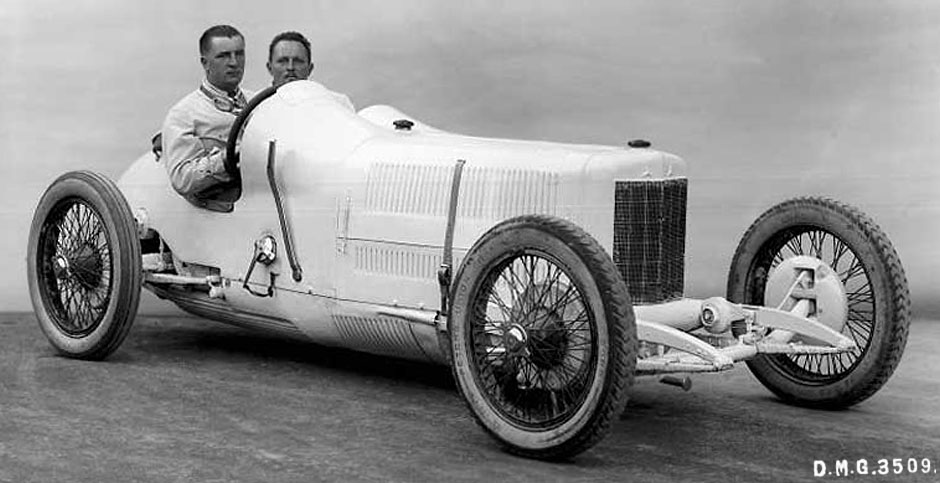

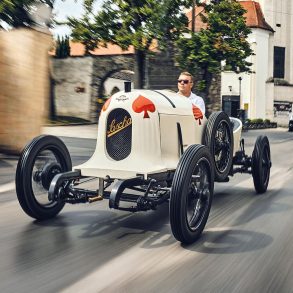
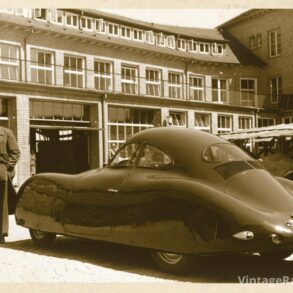
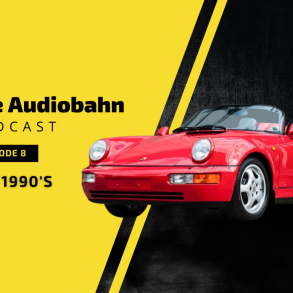
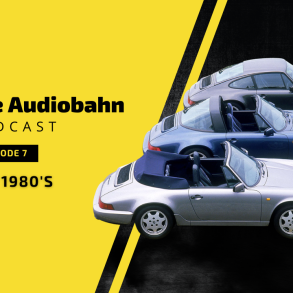

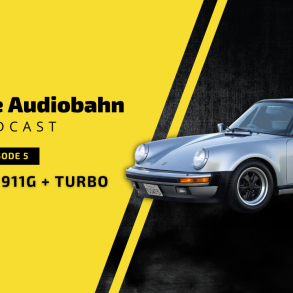
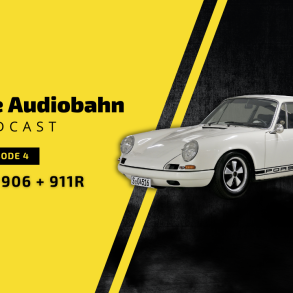
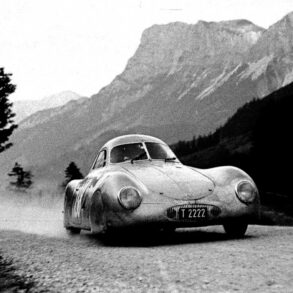
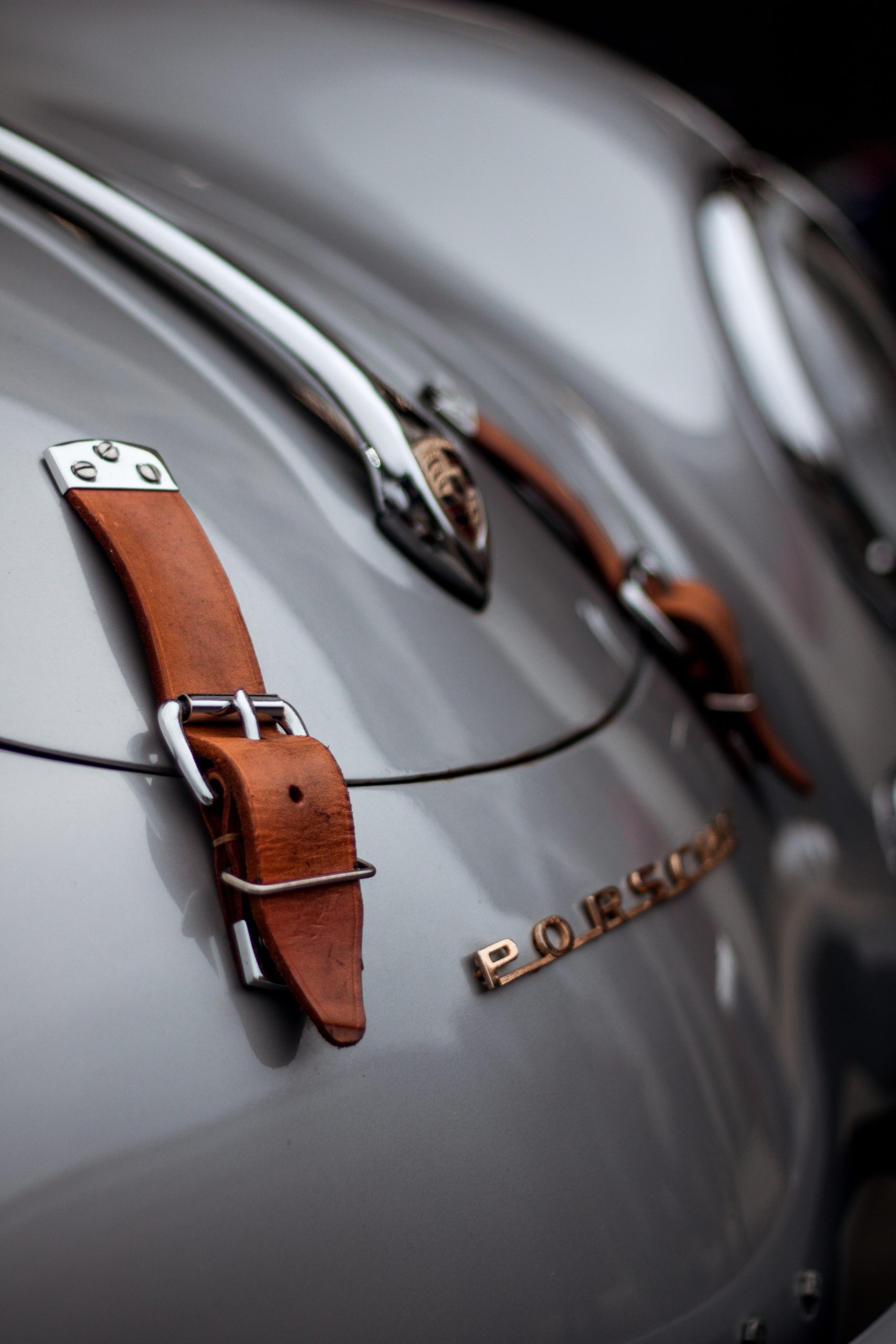
Ferdinand Porsche je bio jedna od najvećih osoba u povijesti čovječanstva.
Nediljko Matić
0